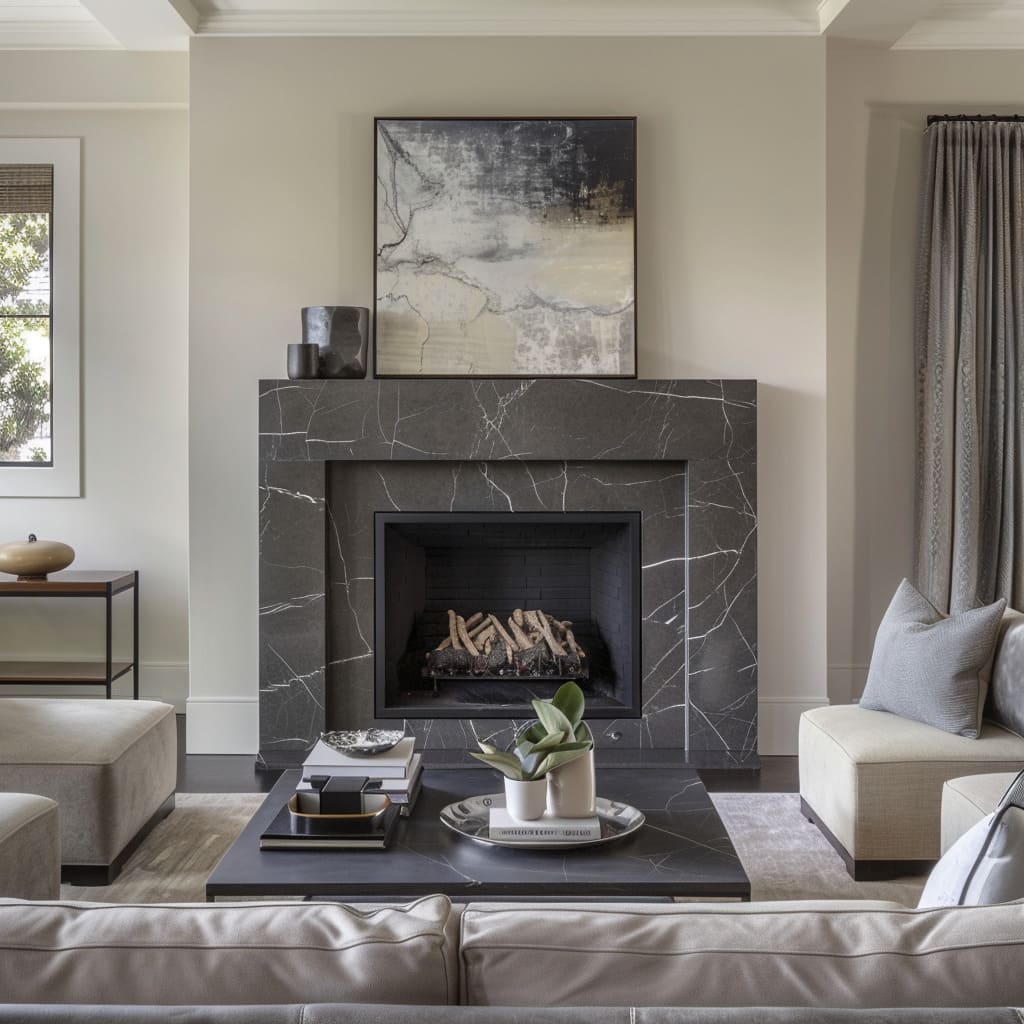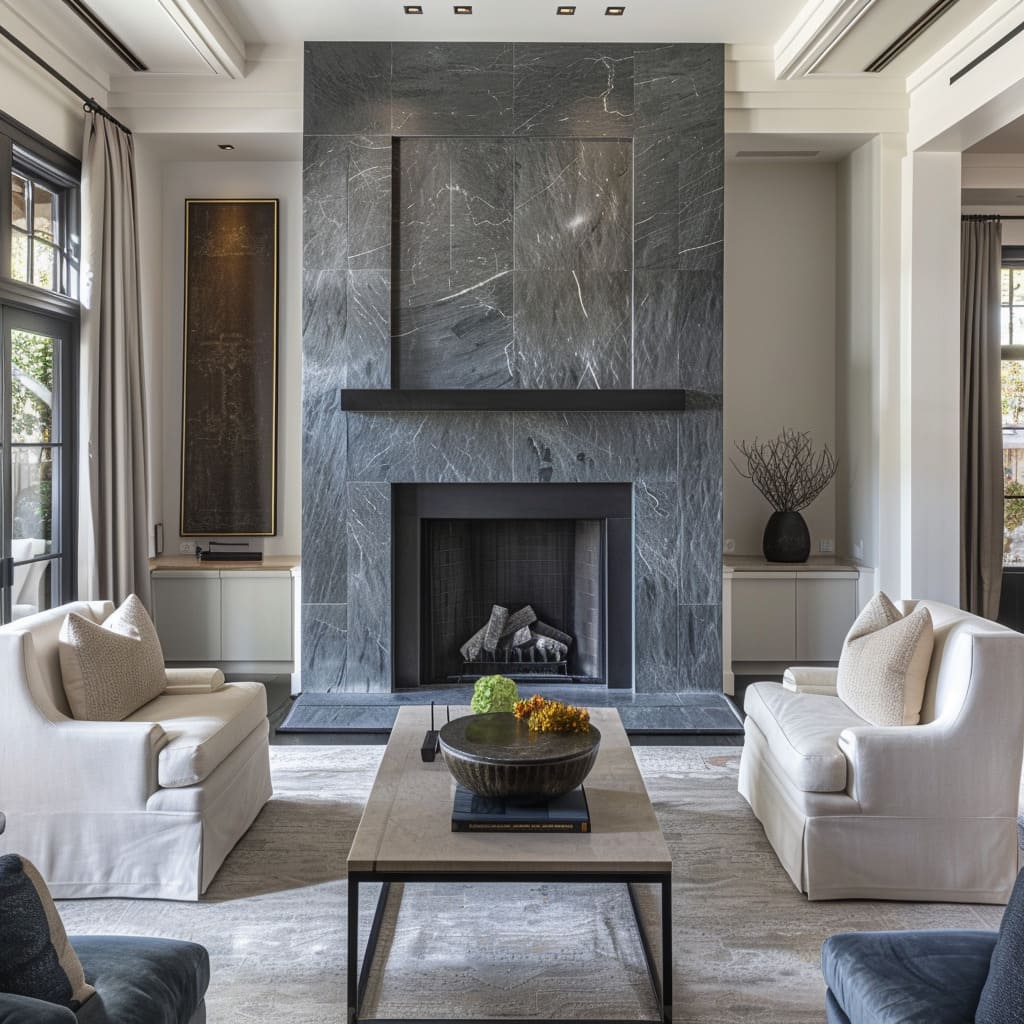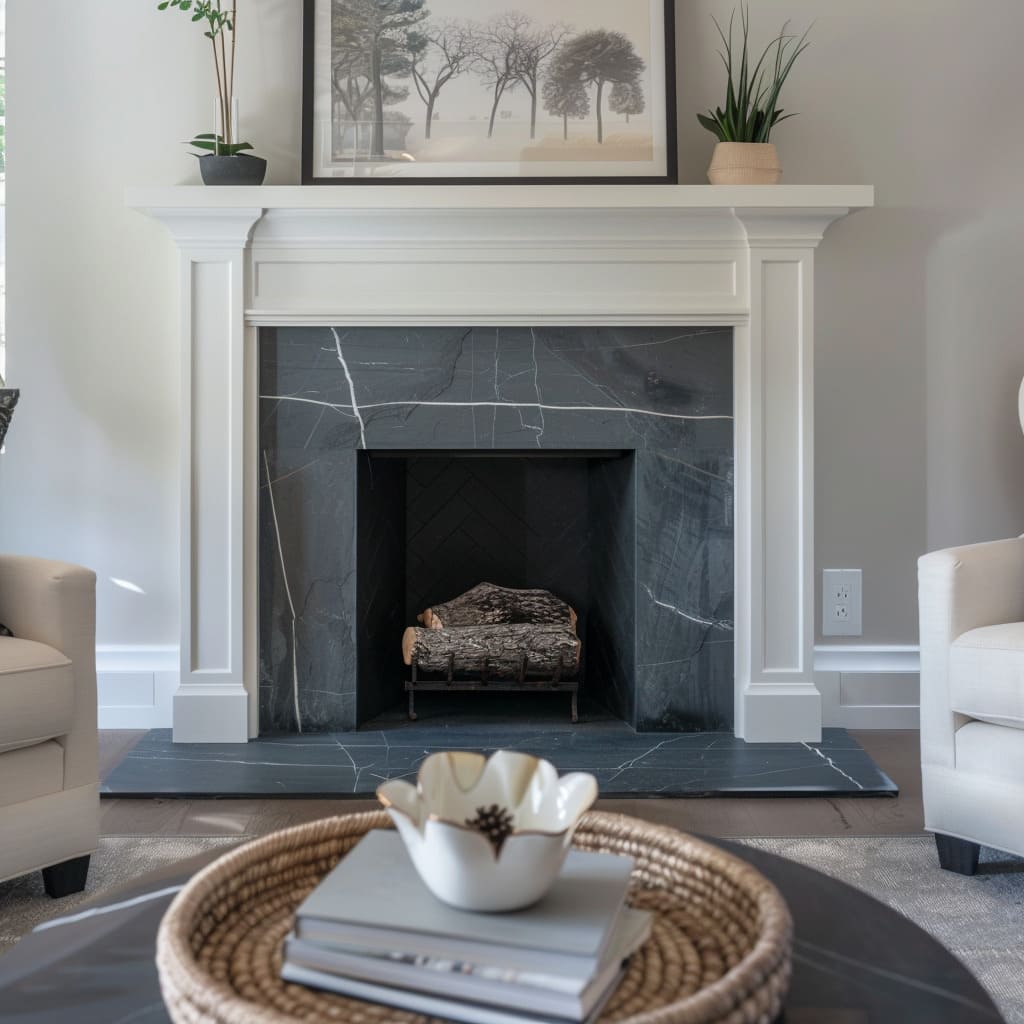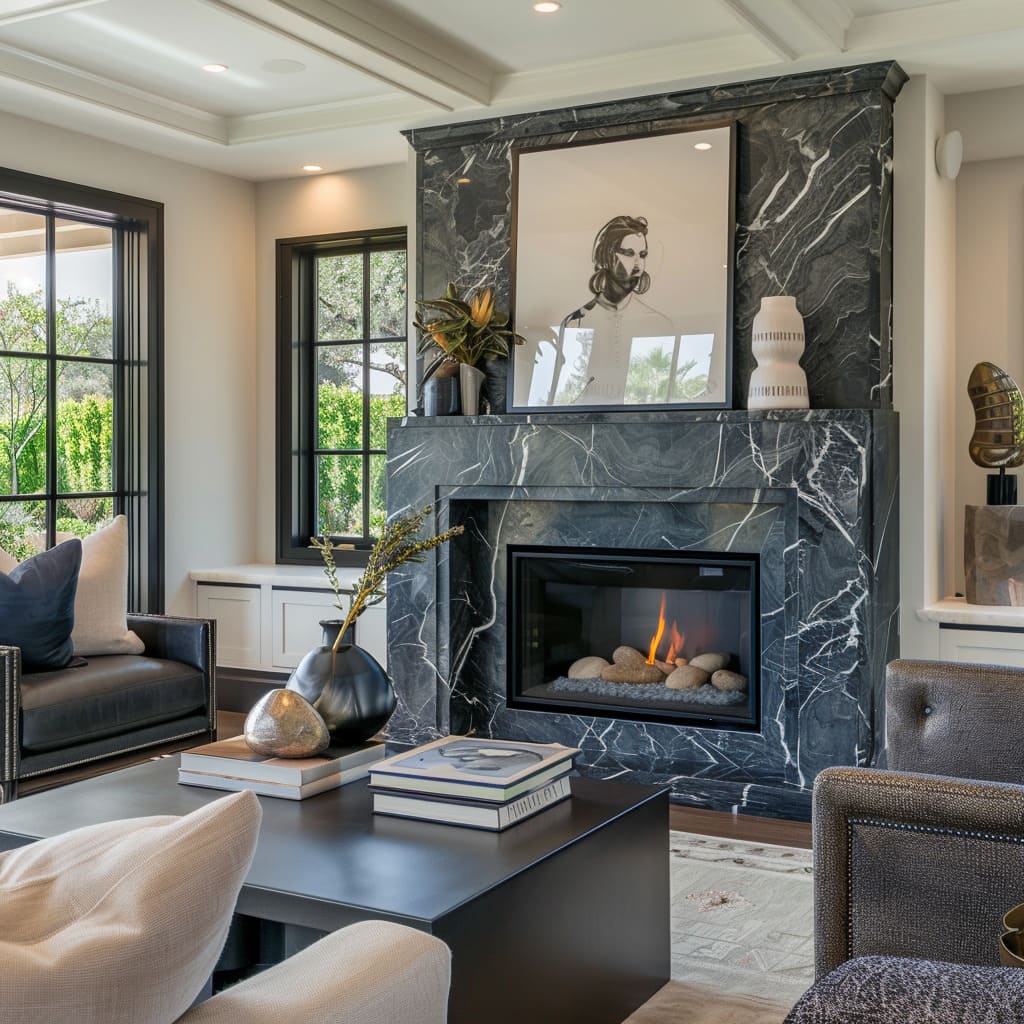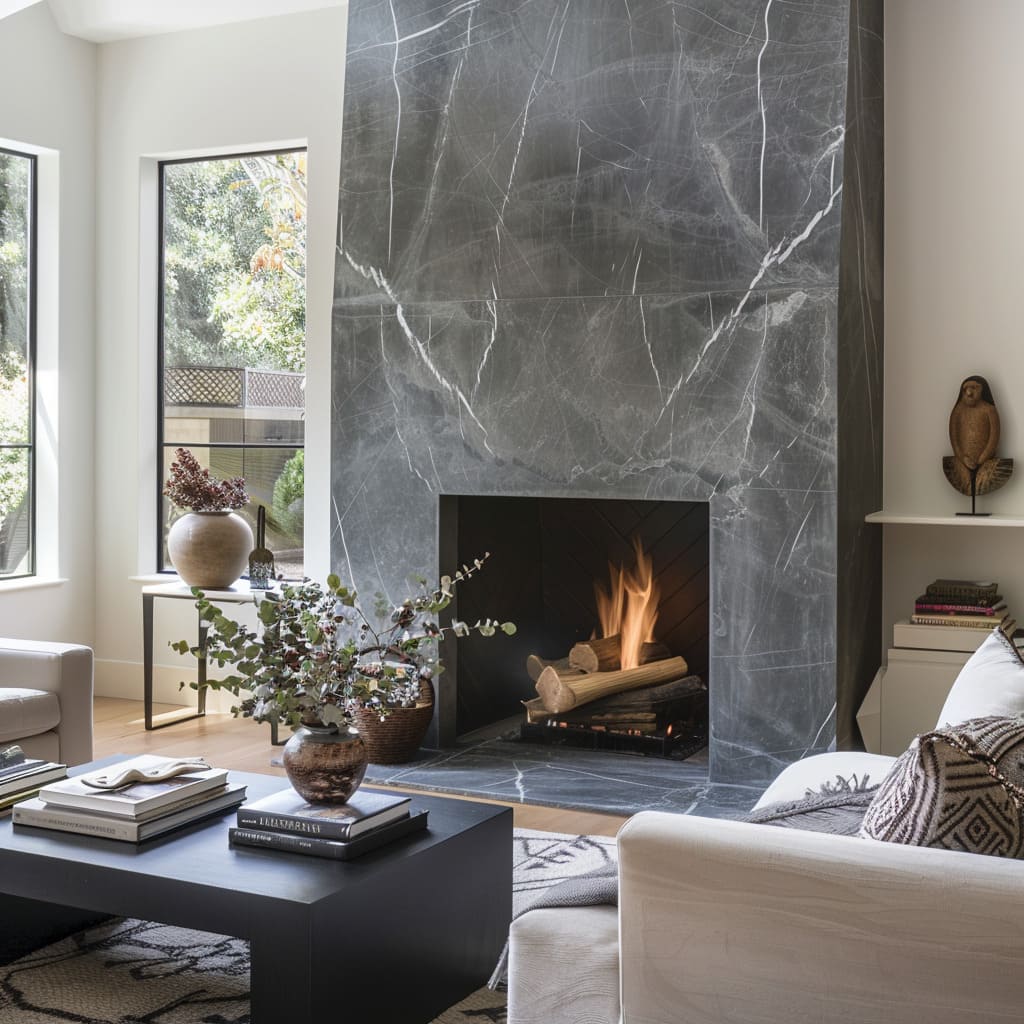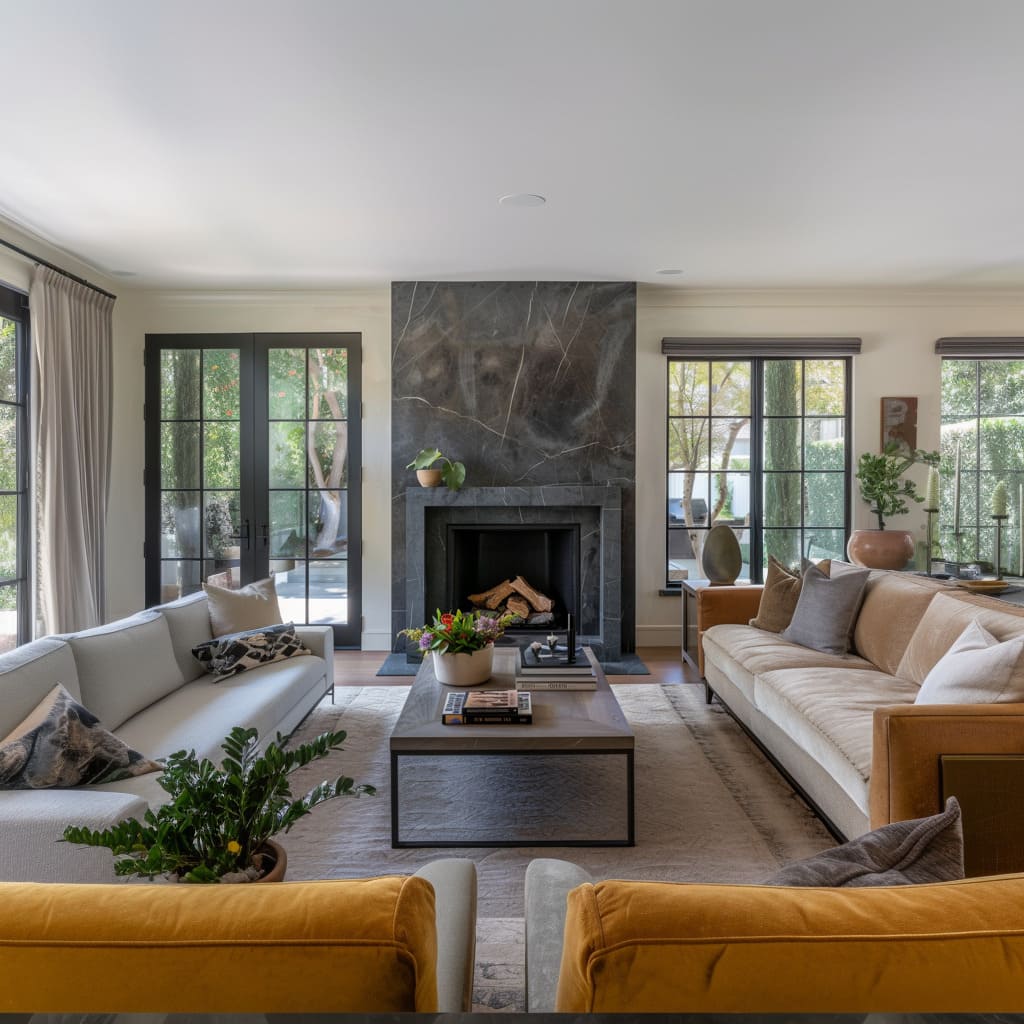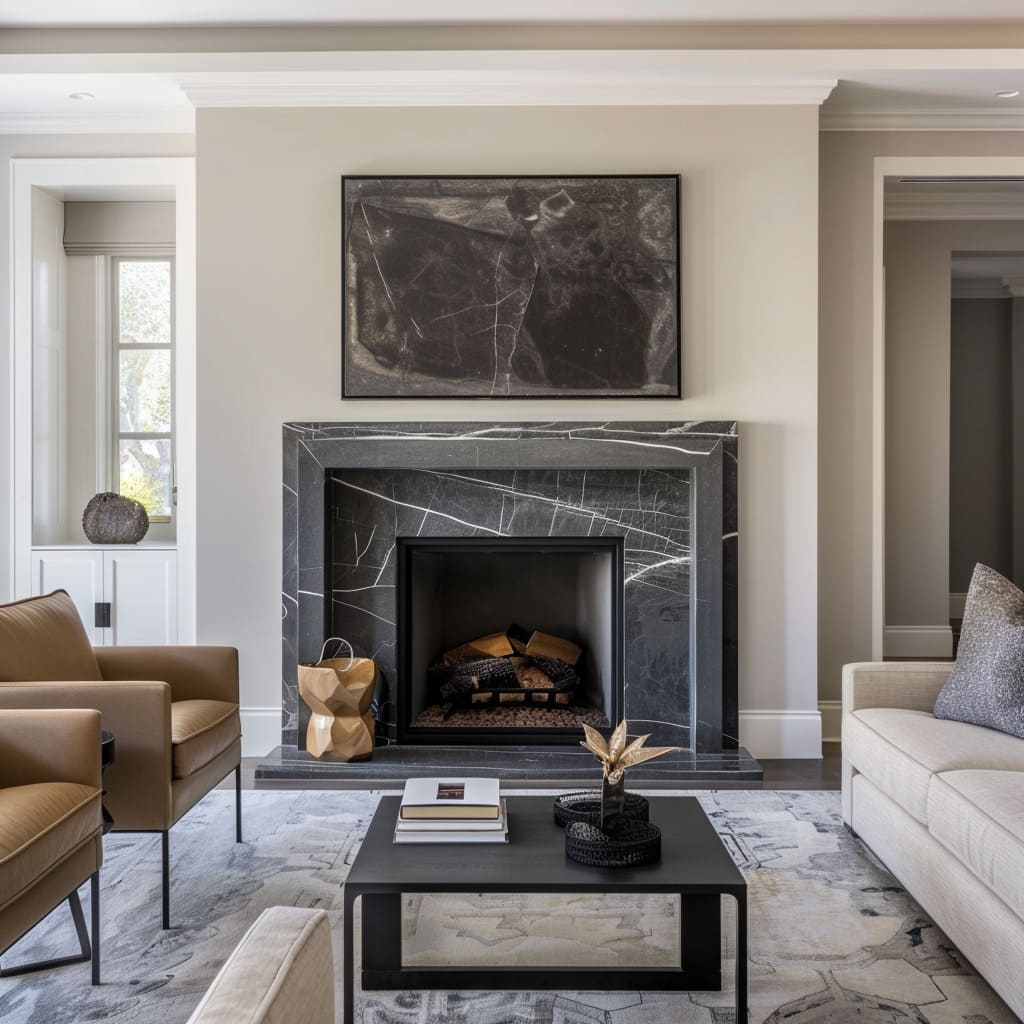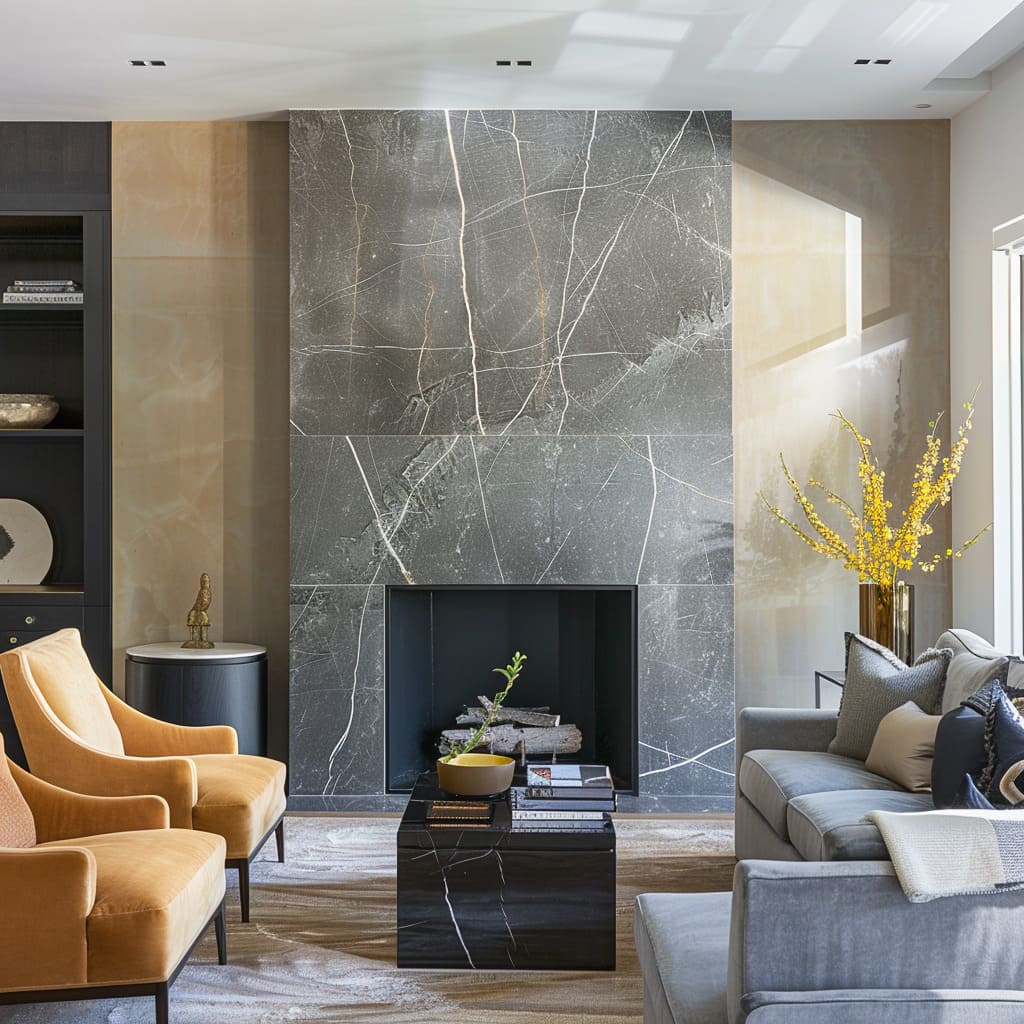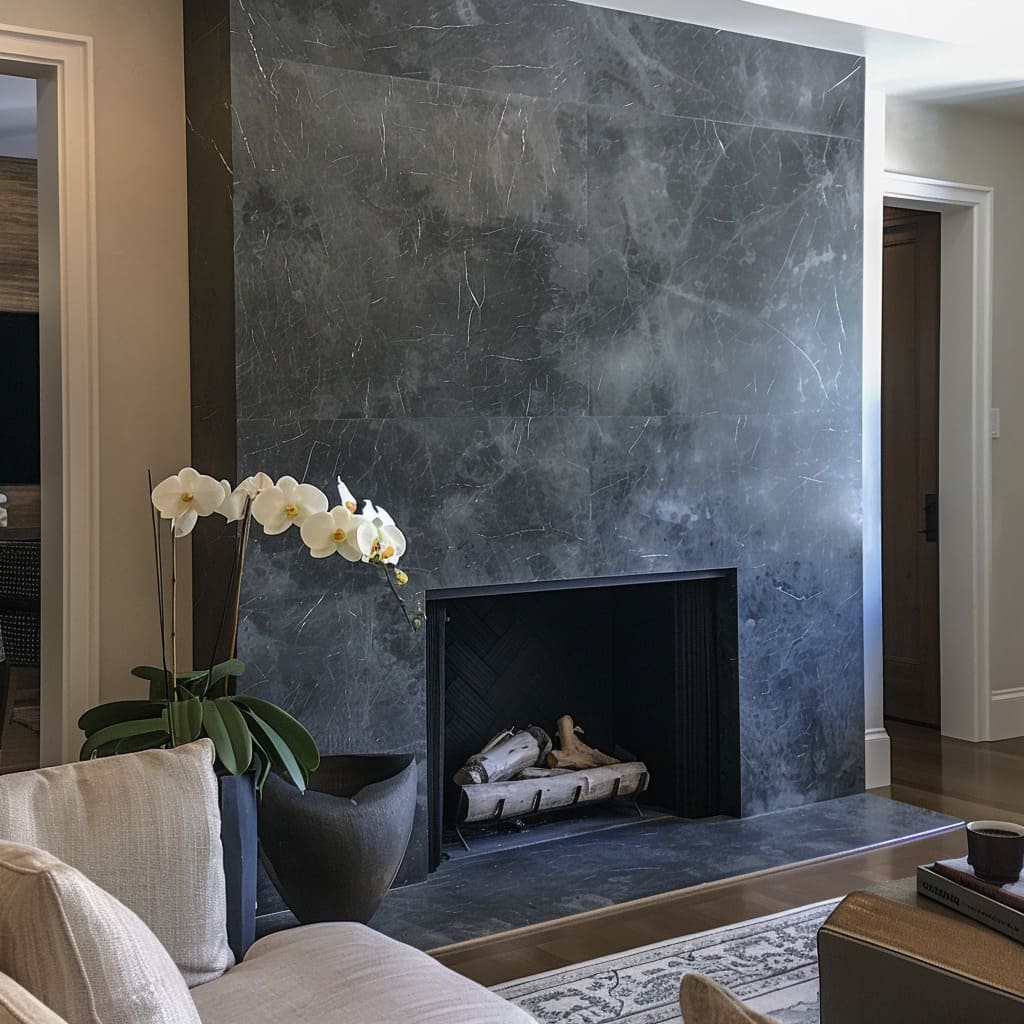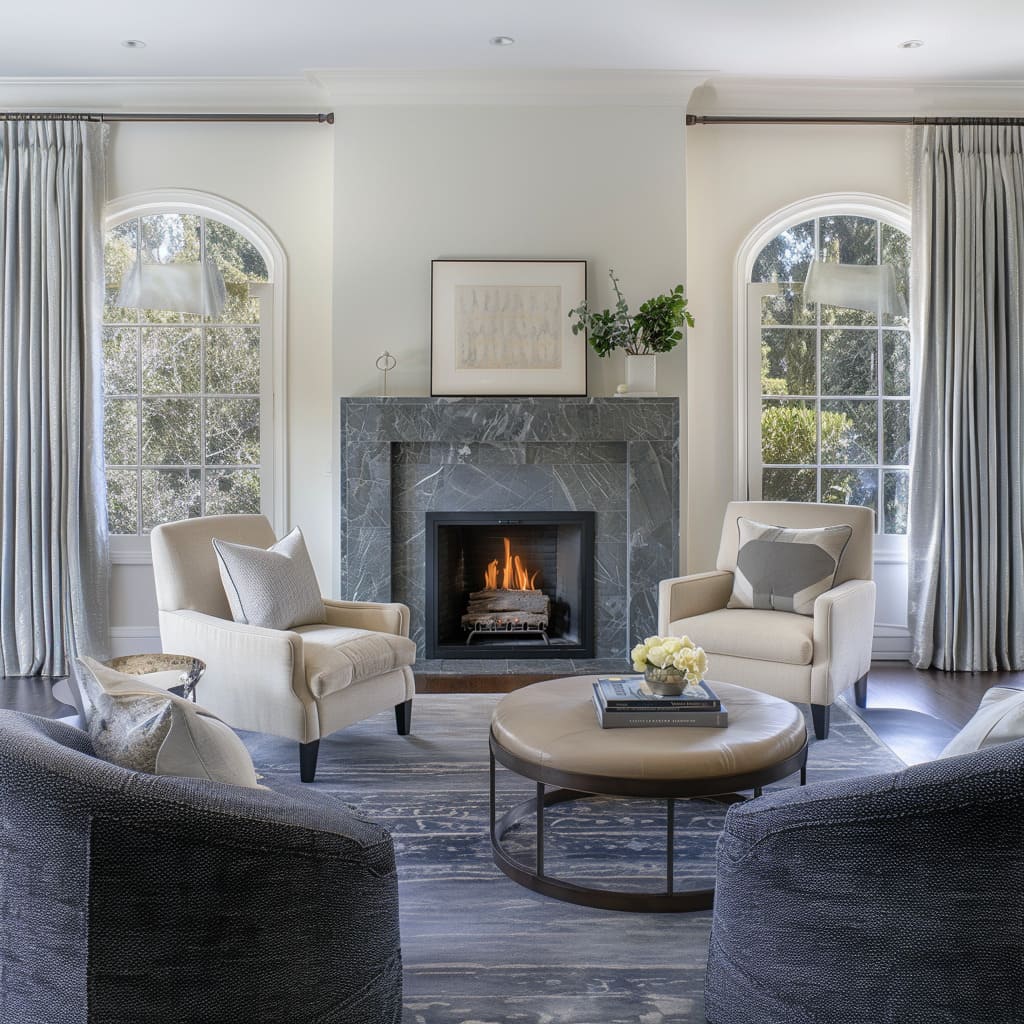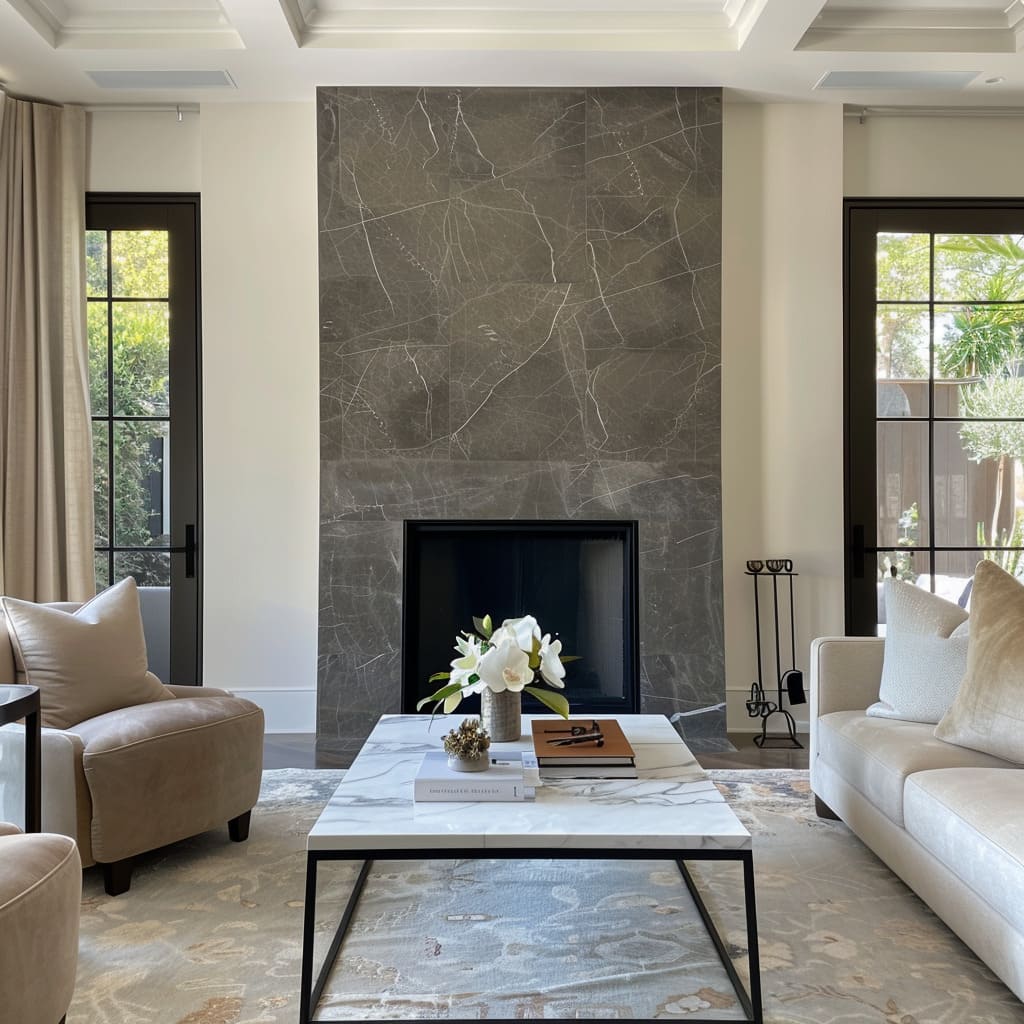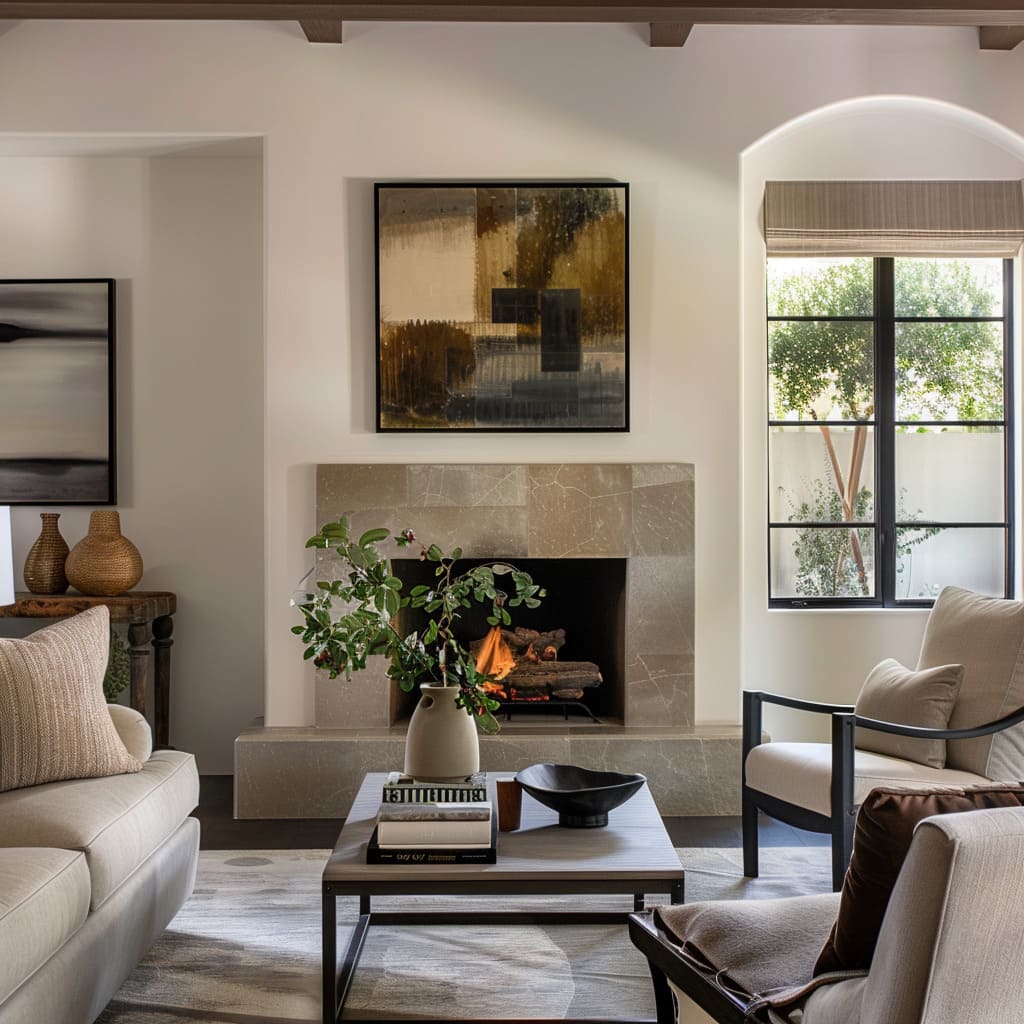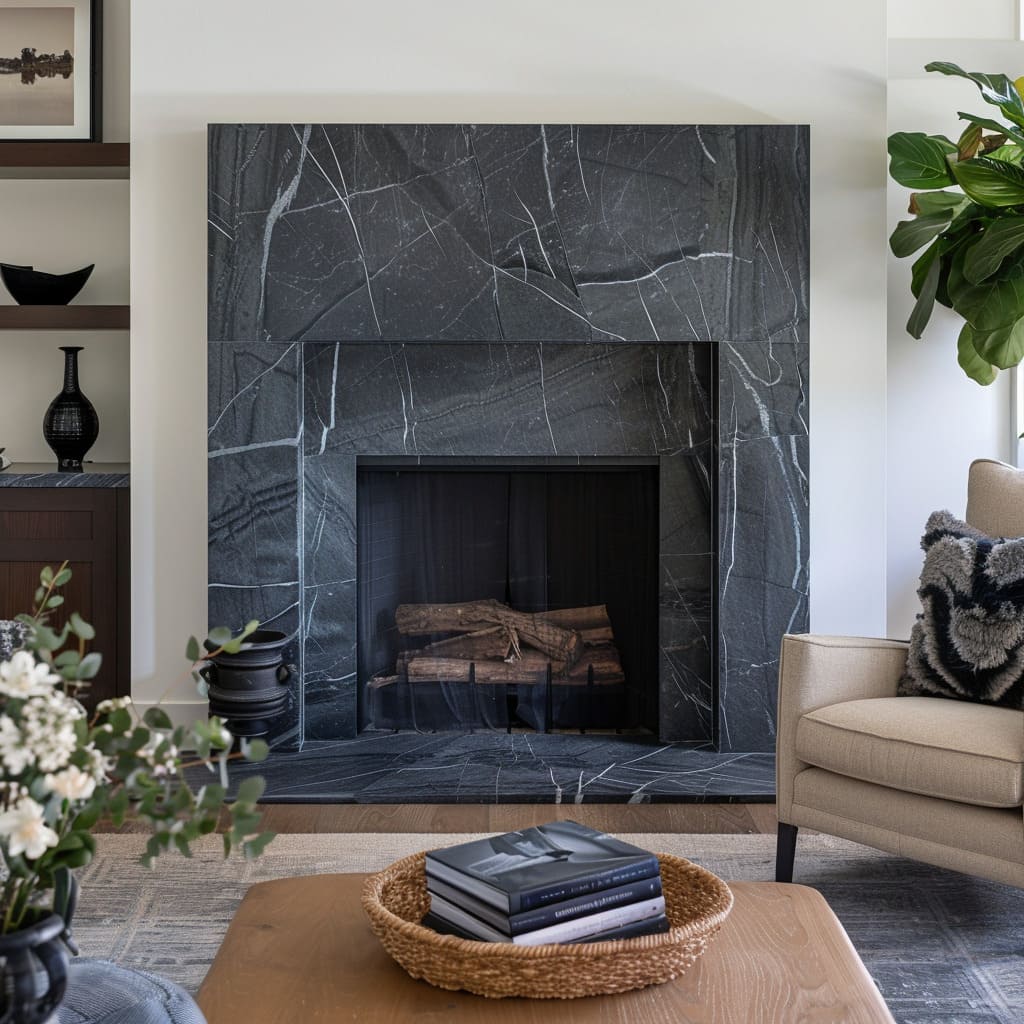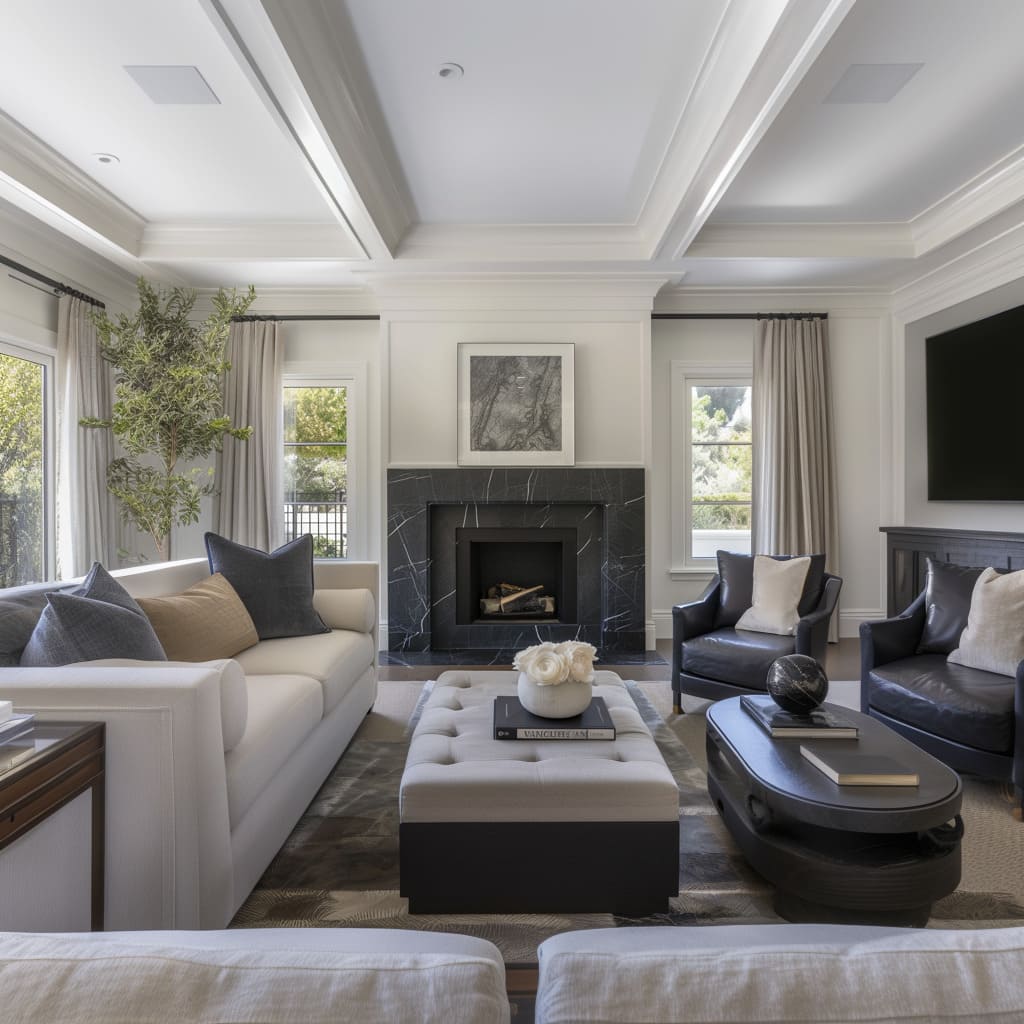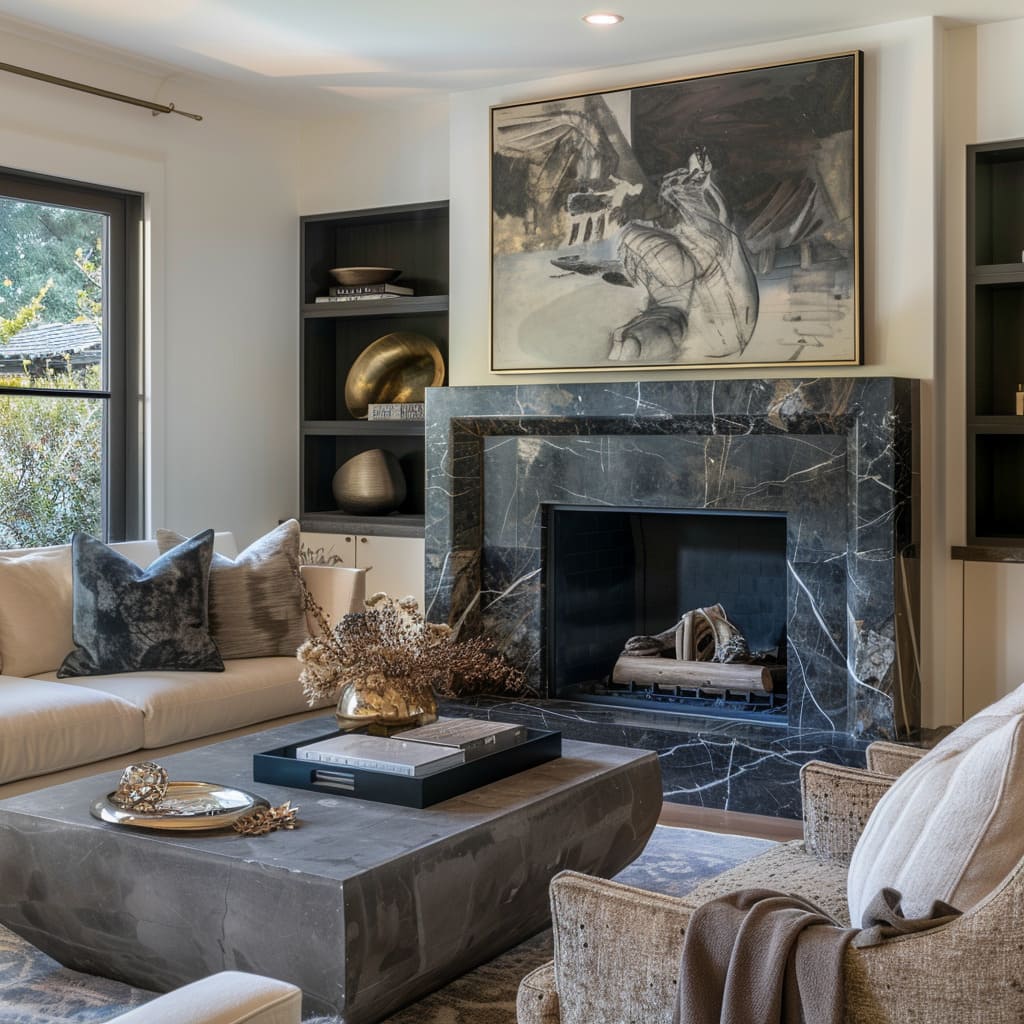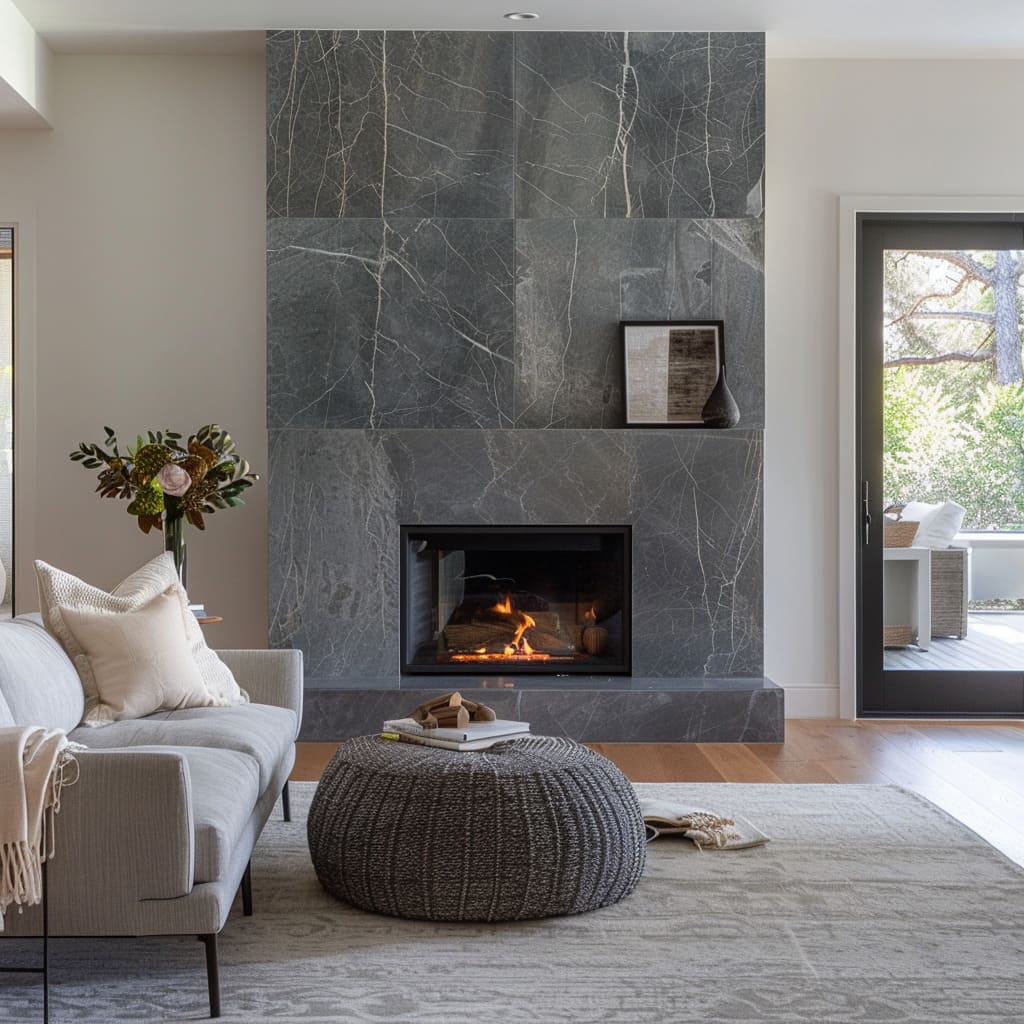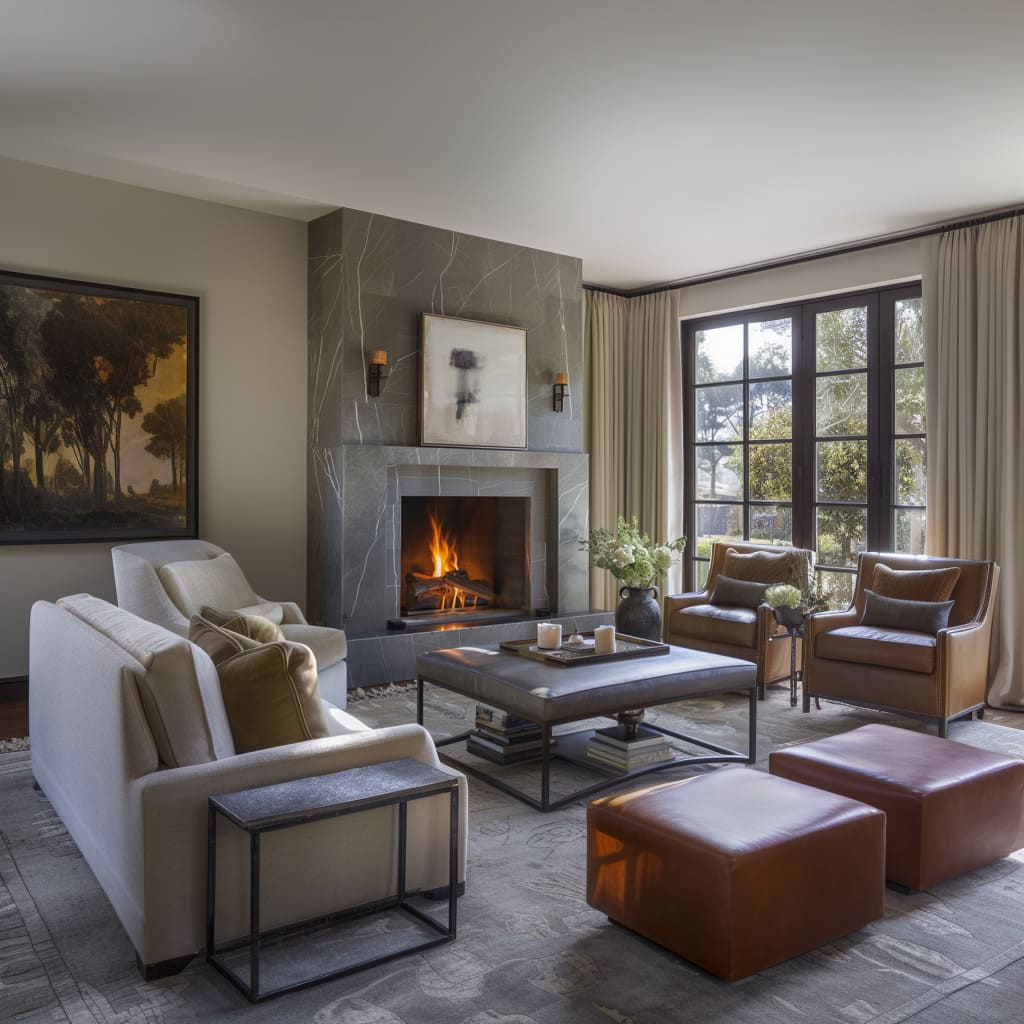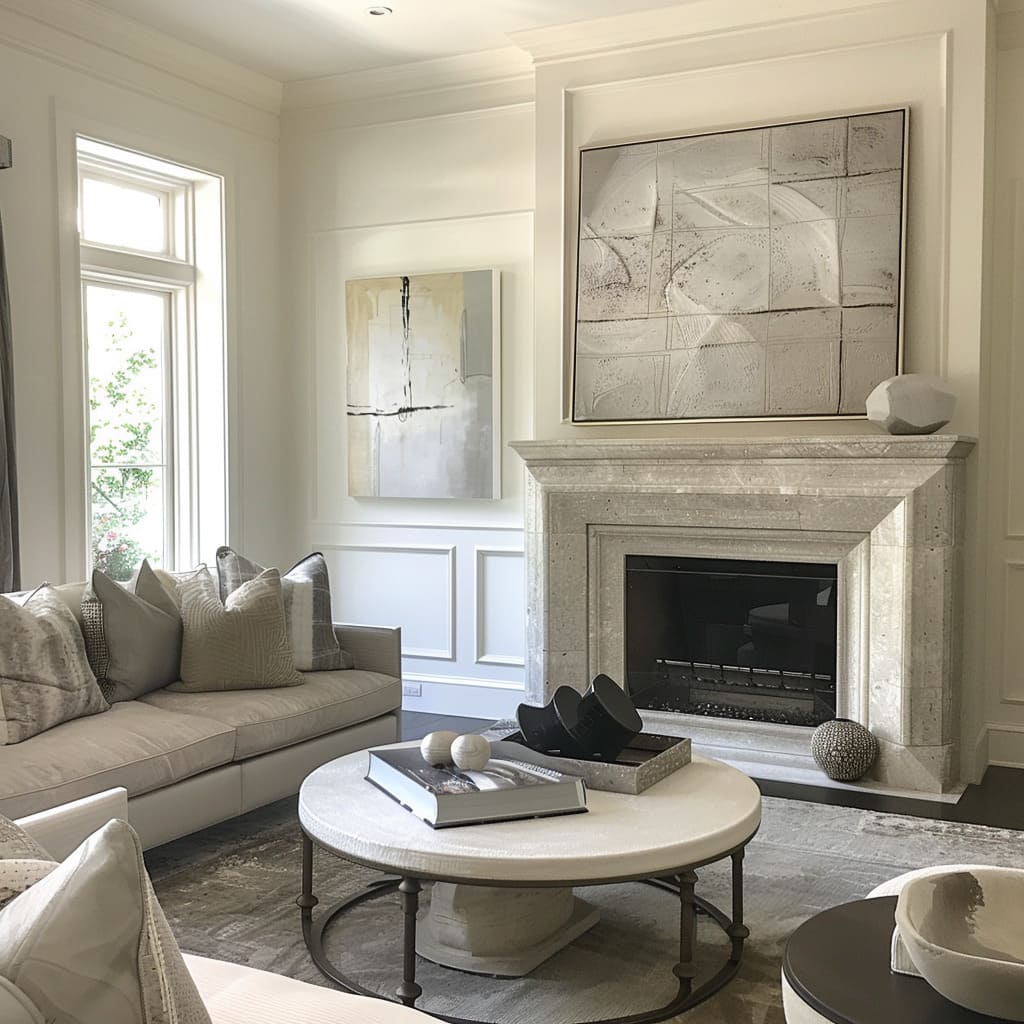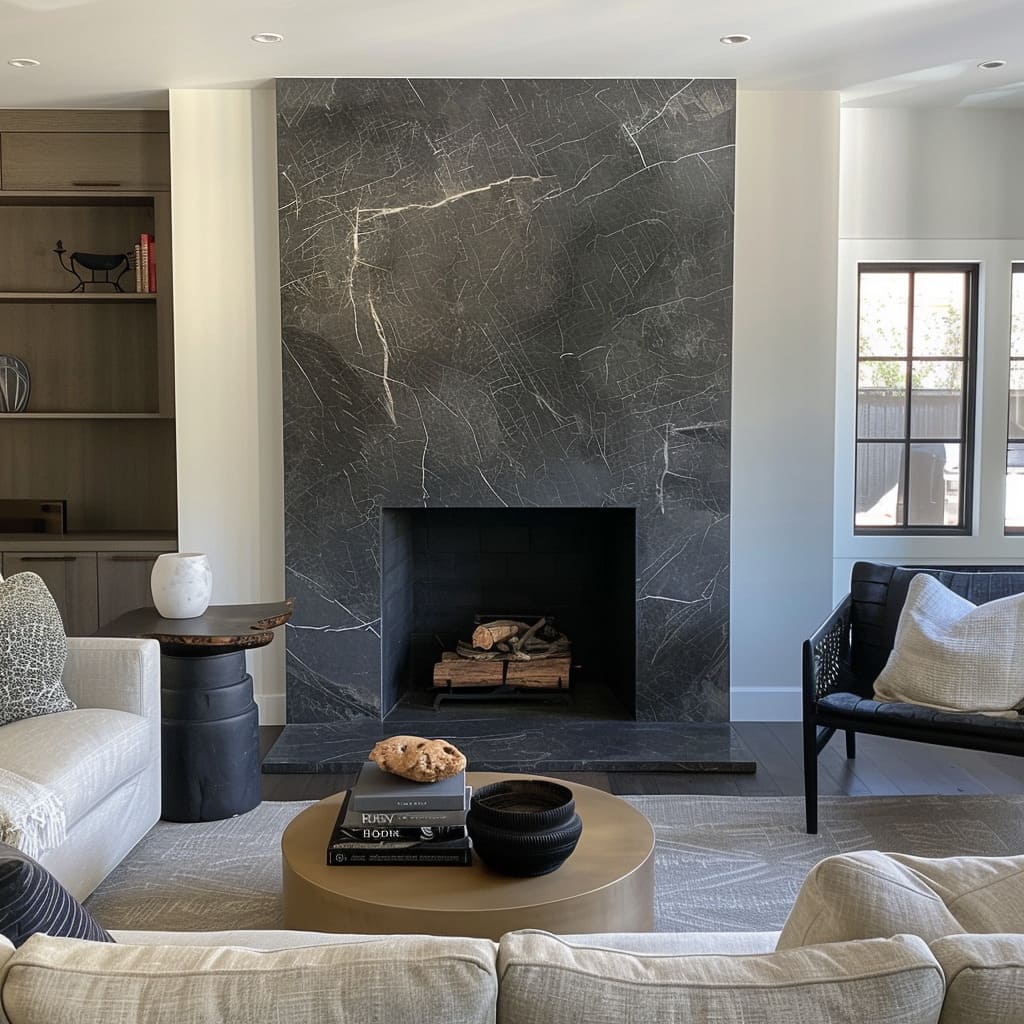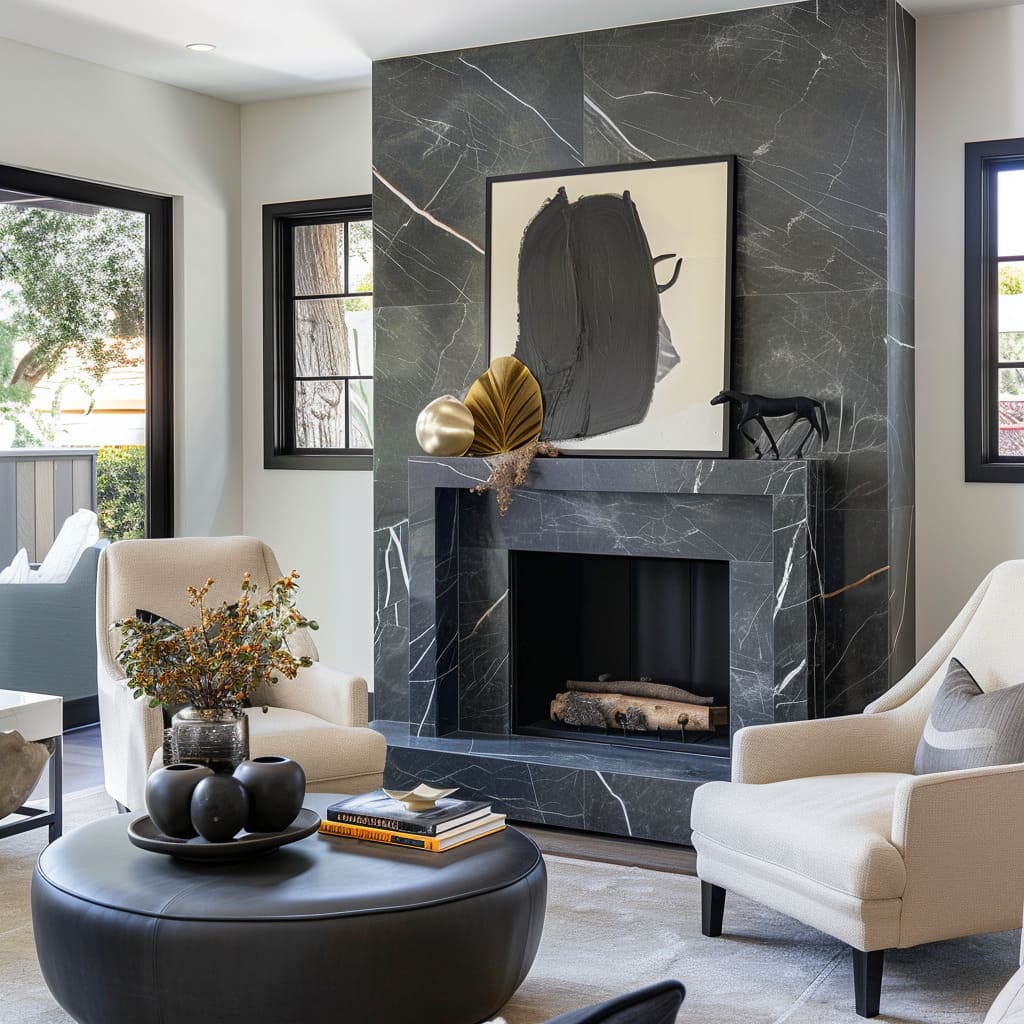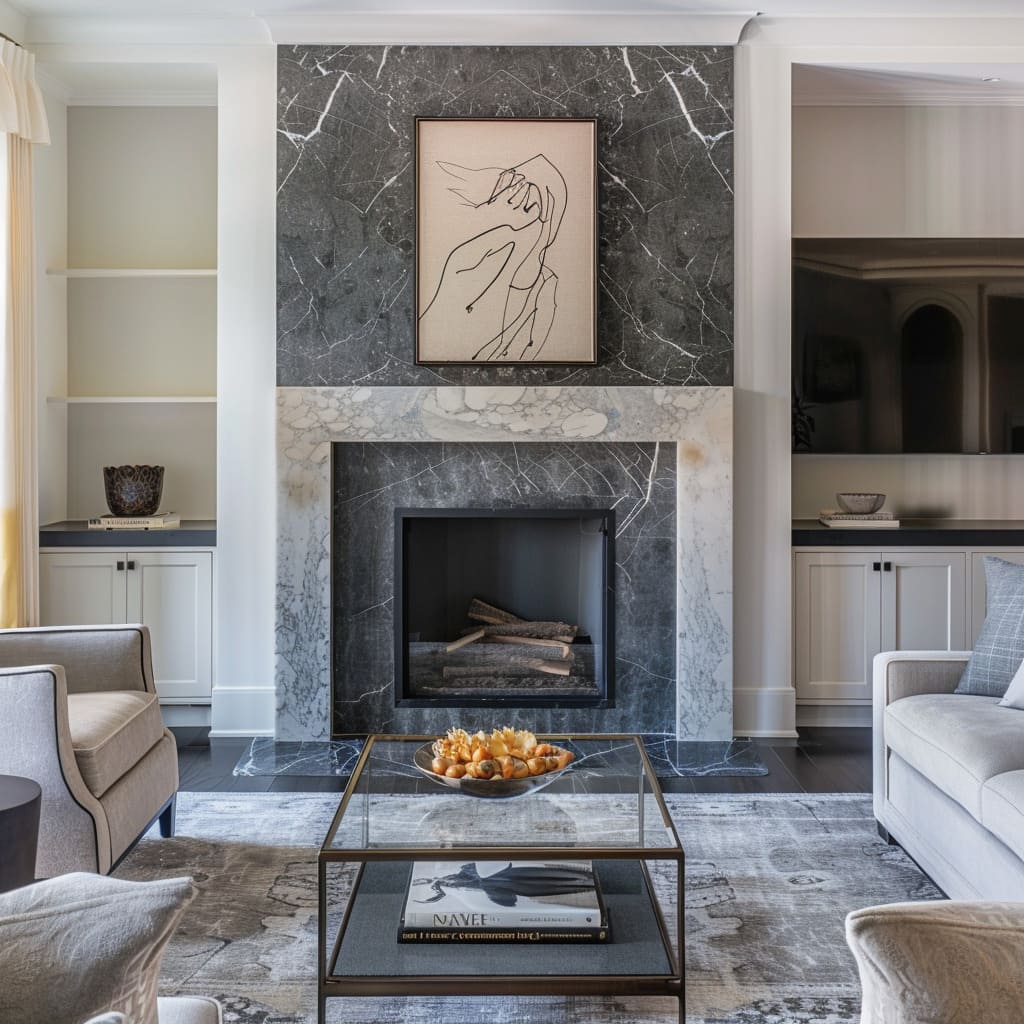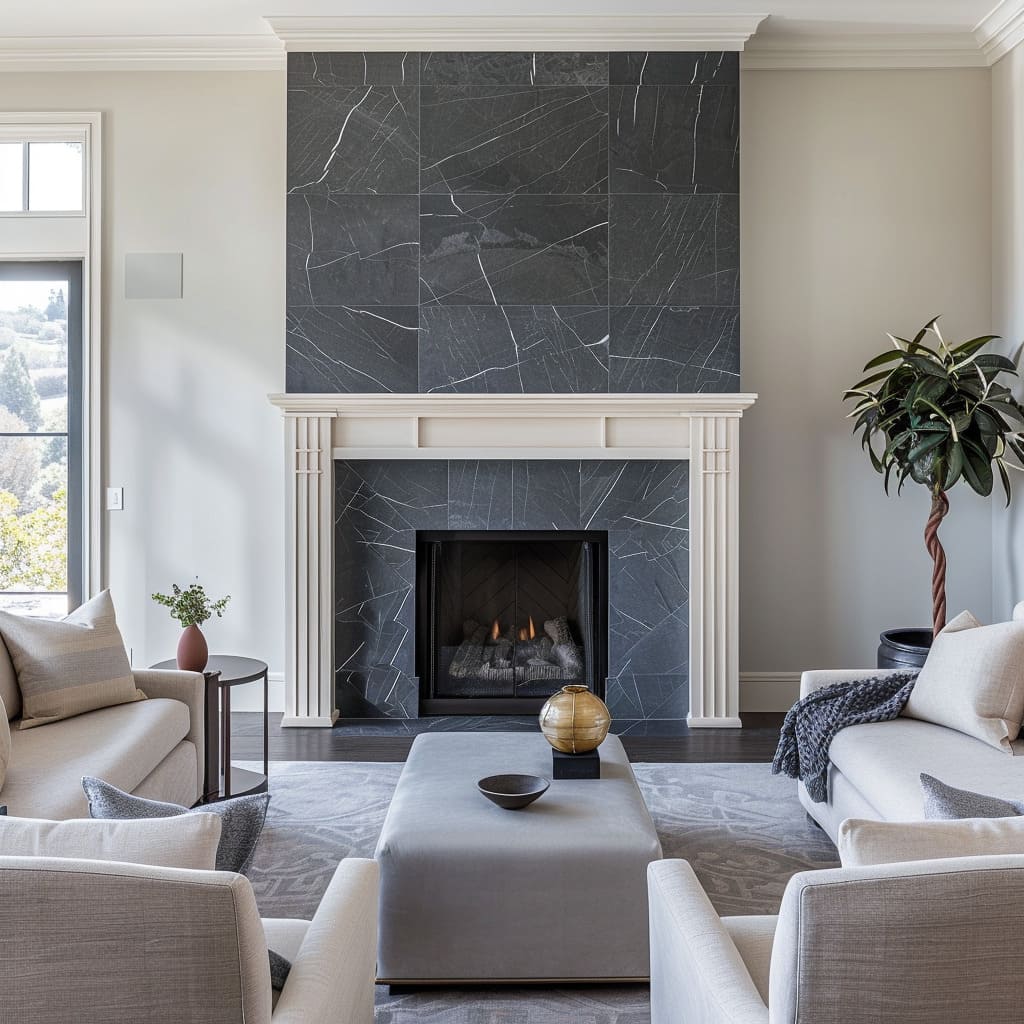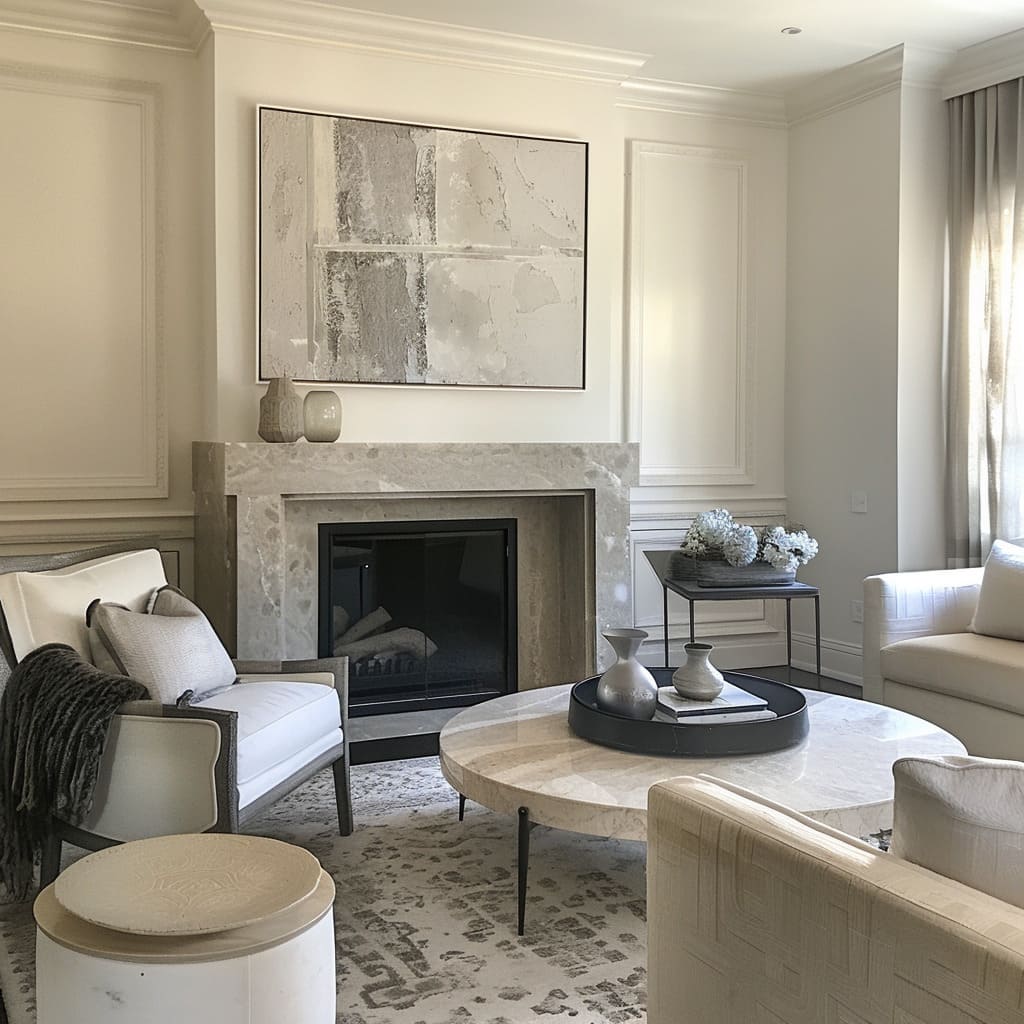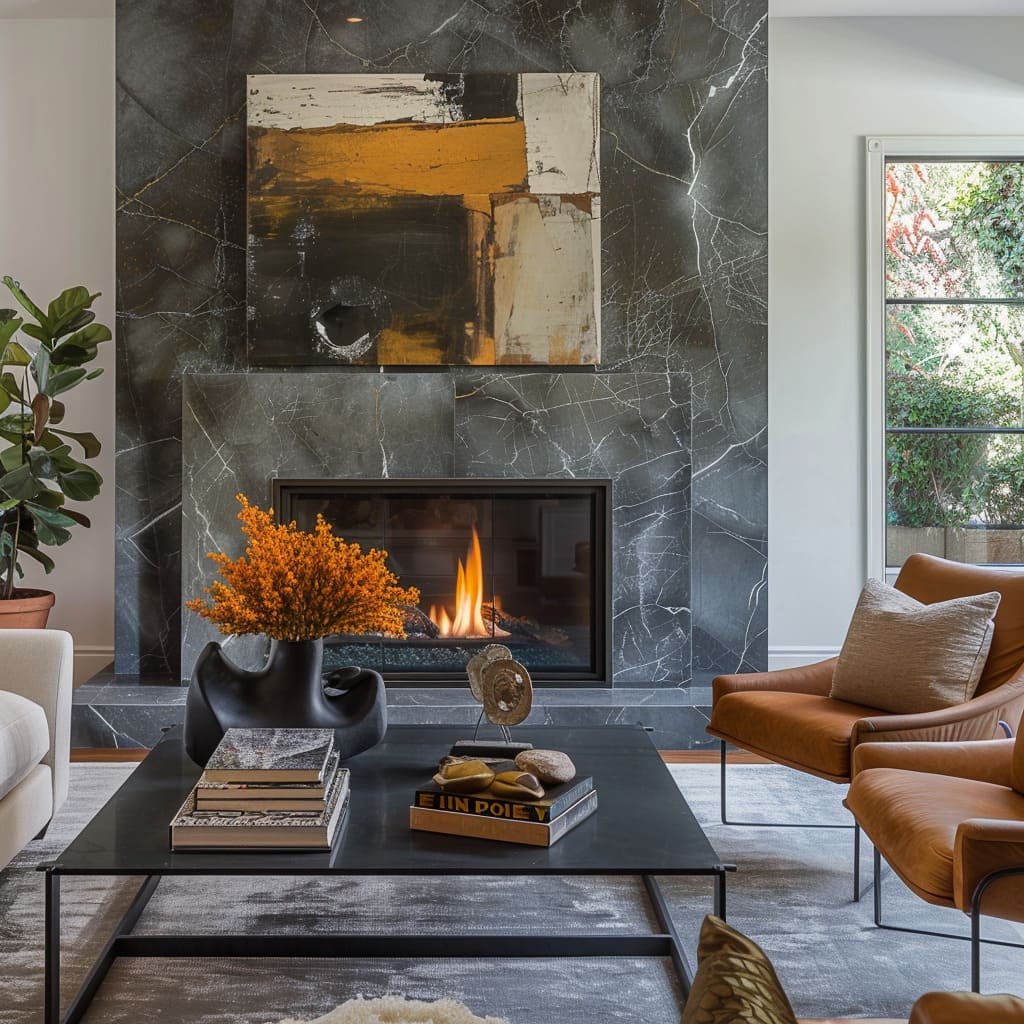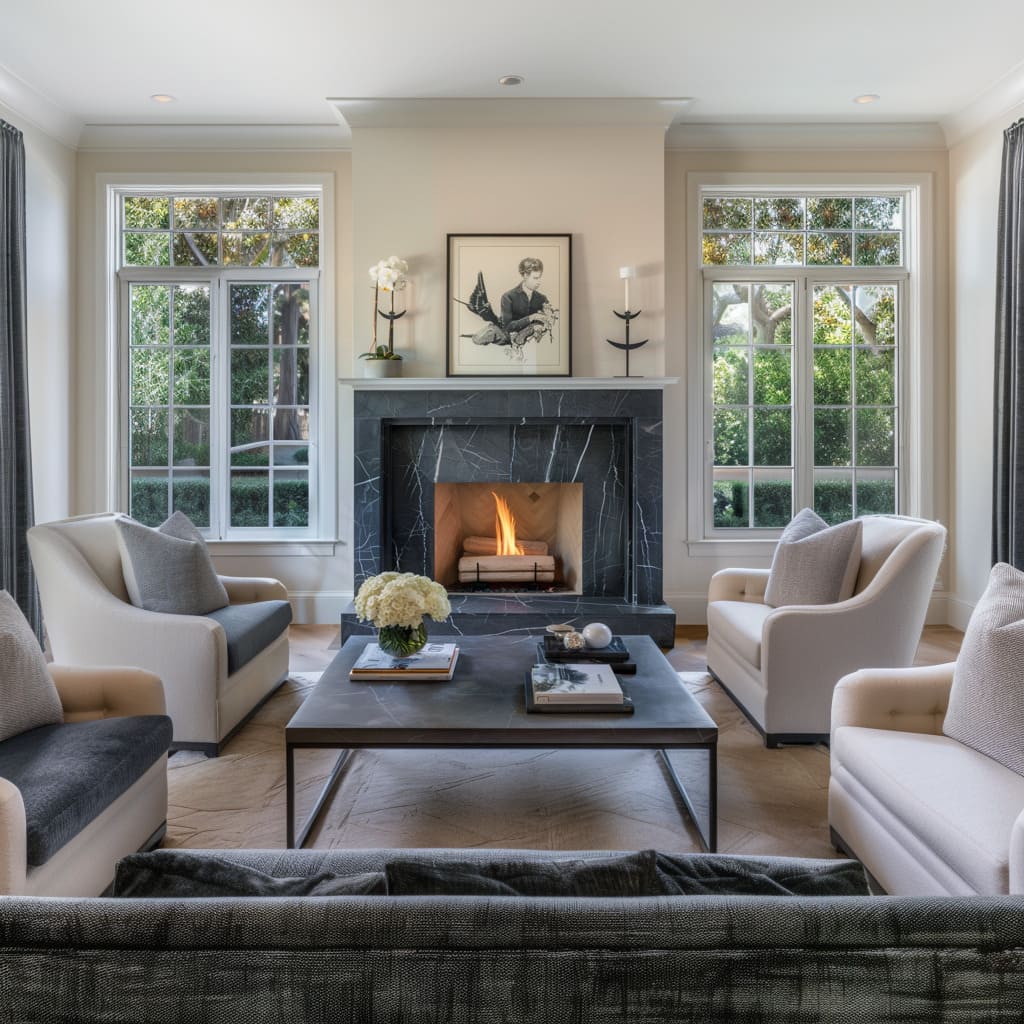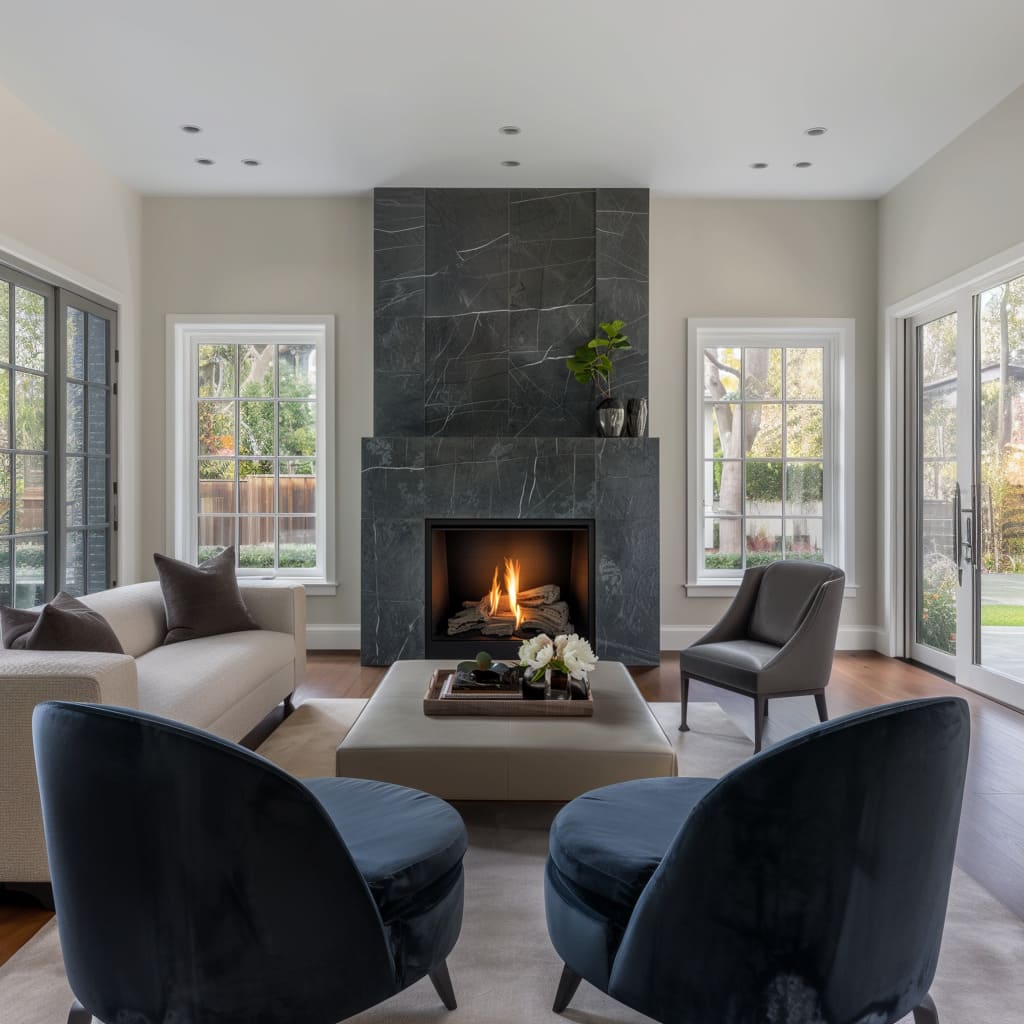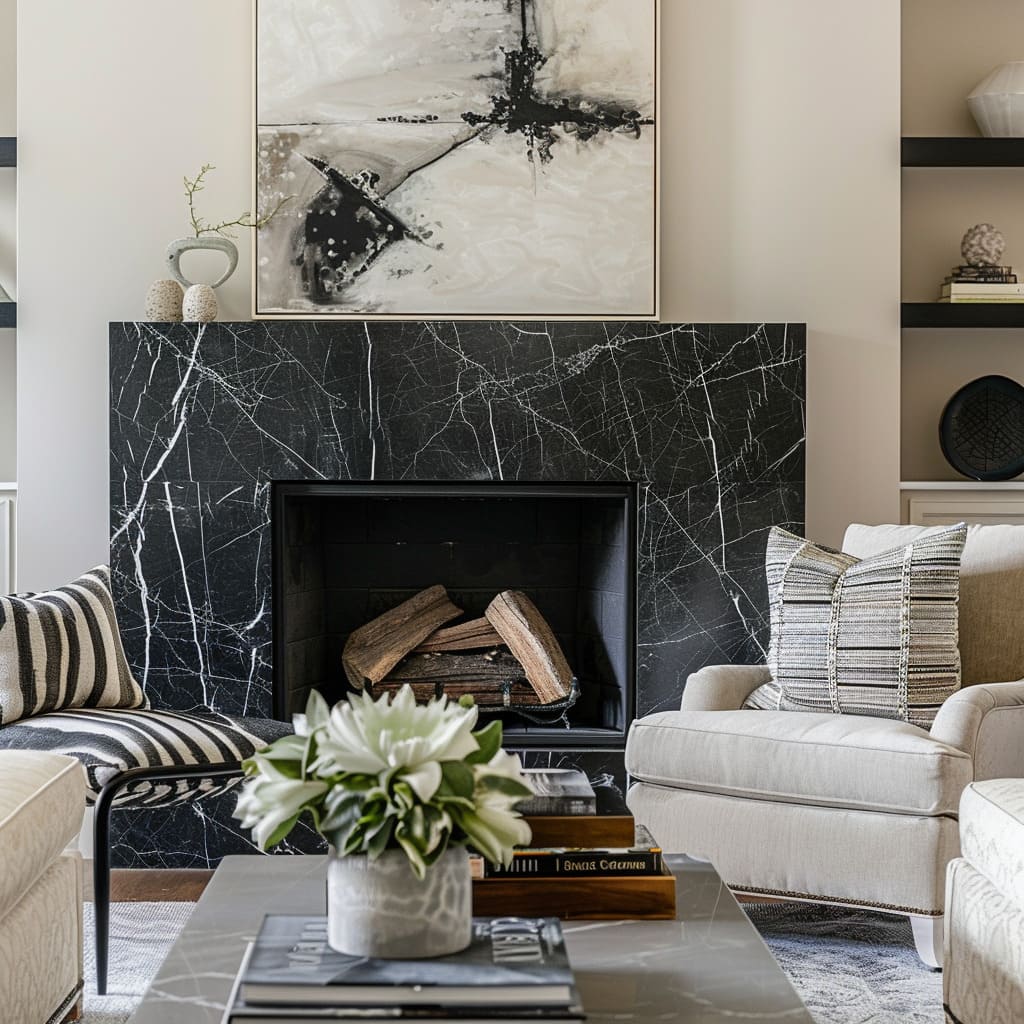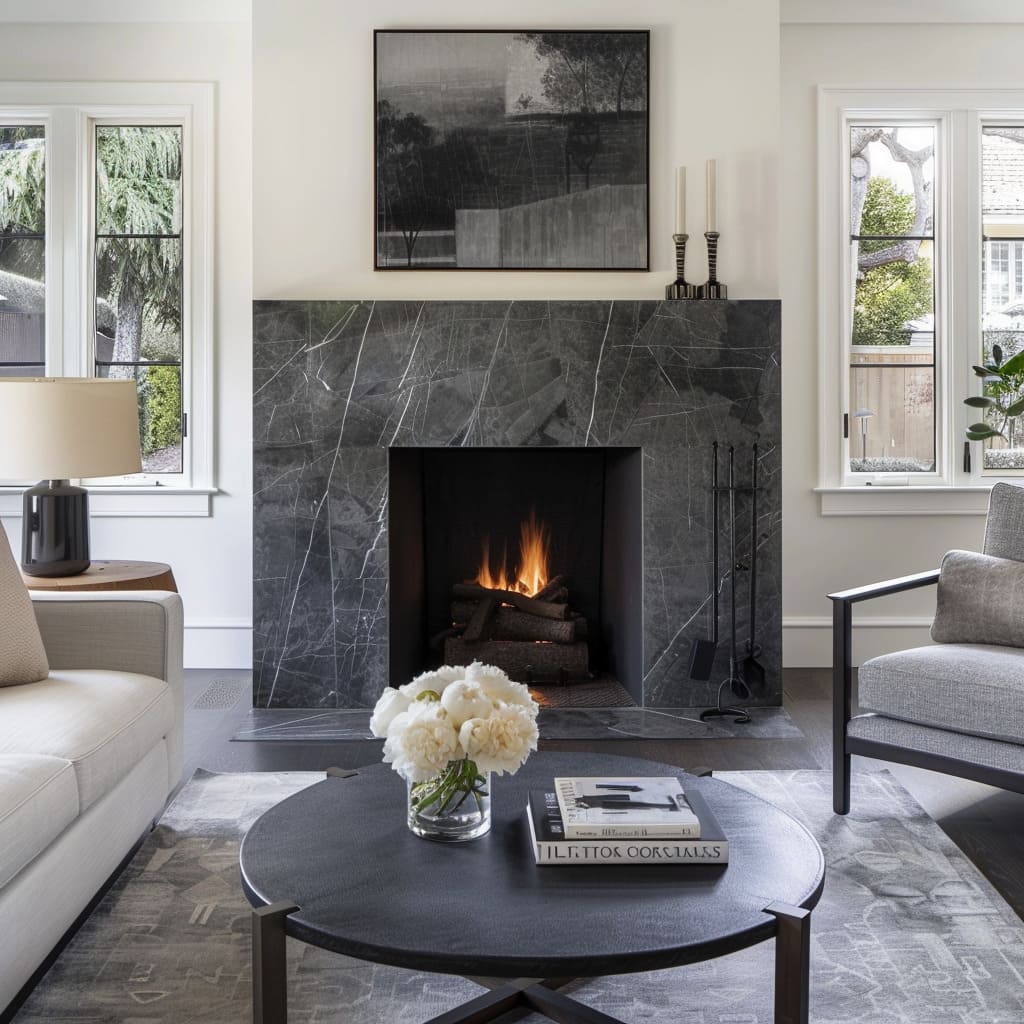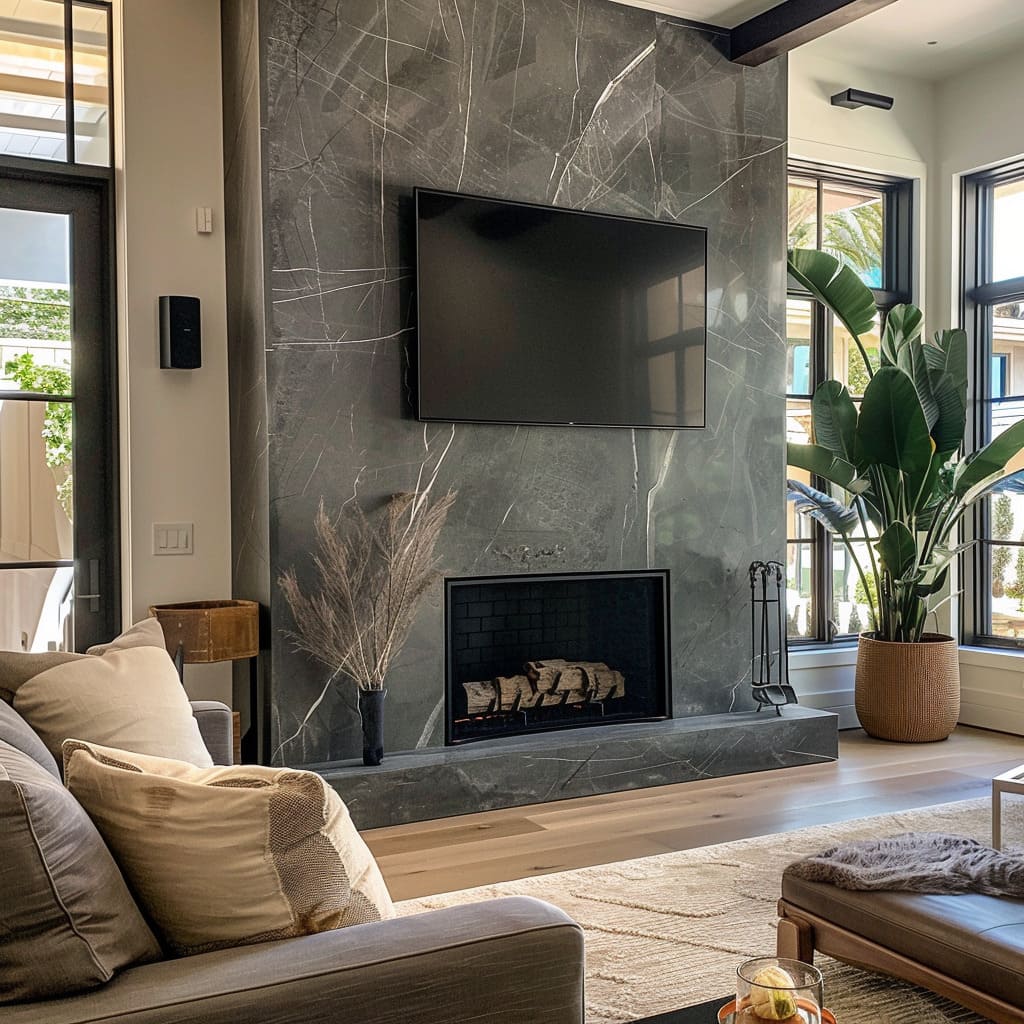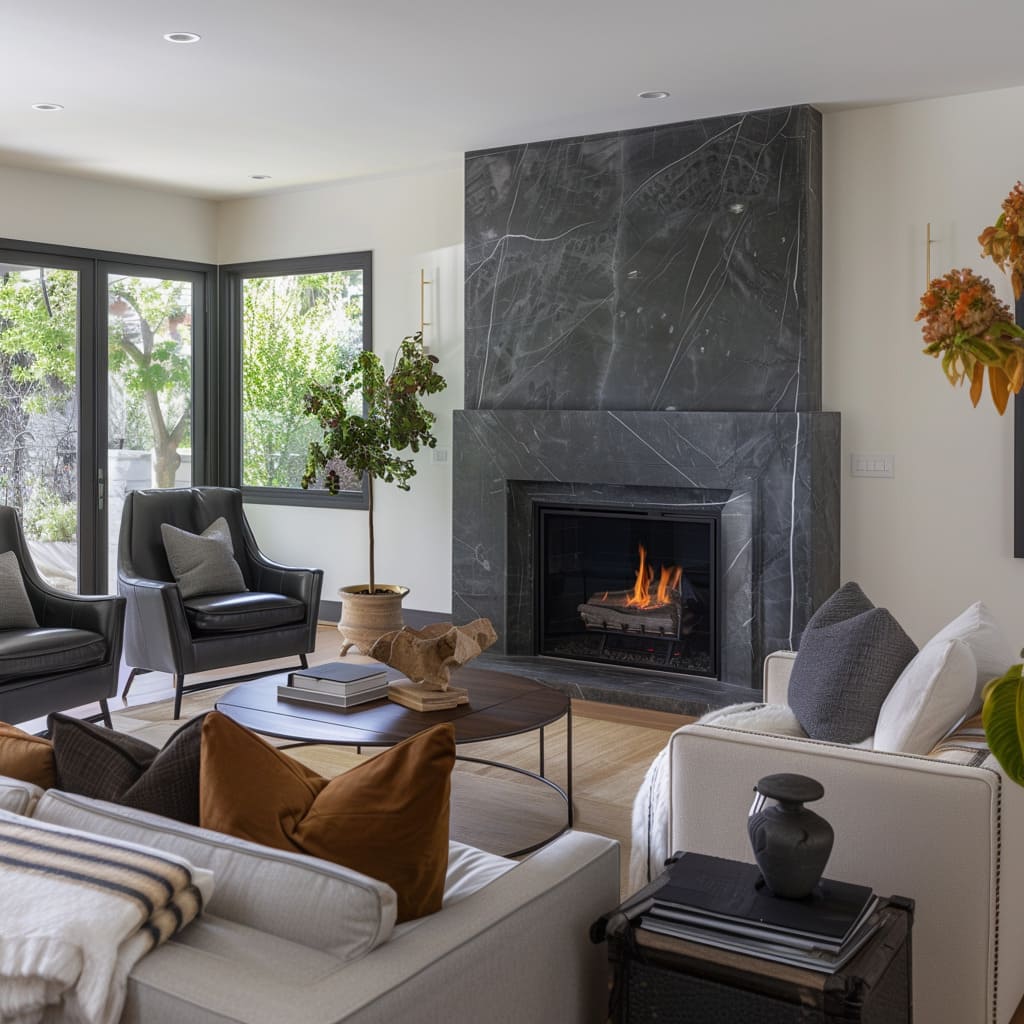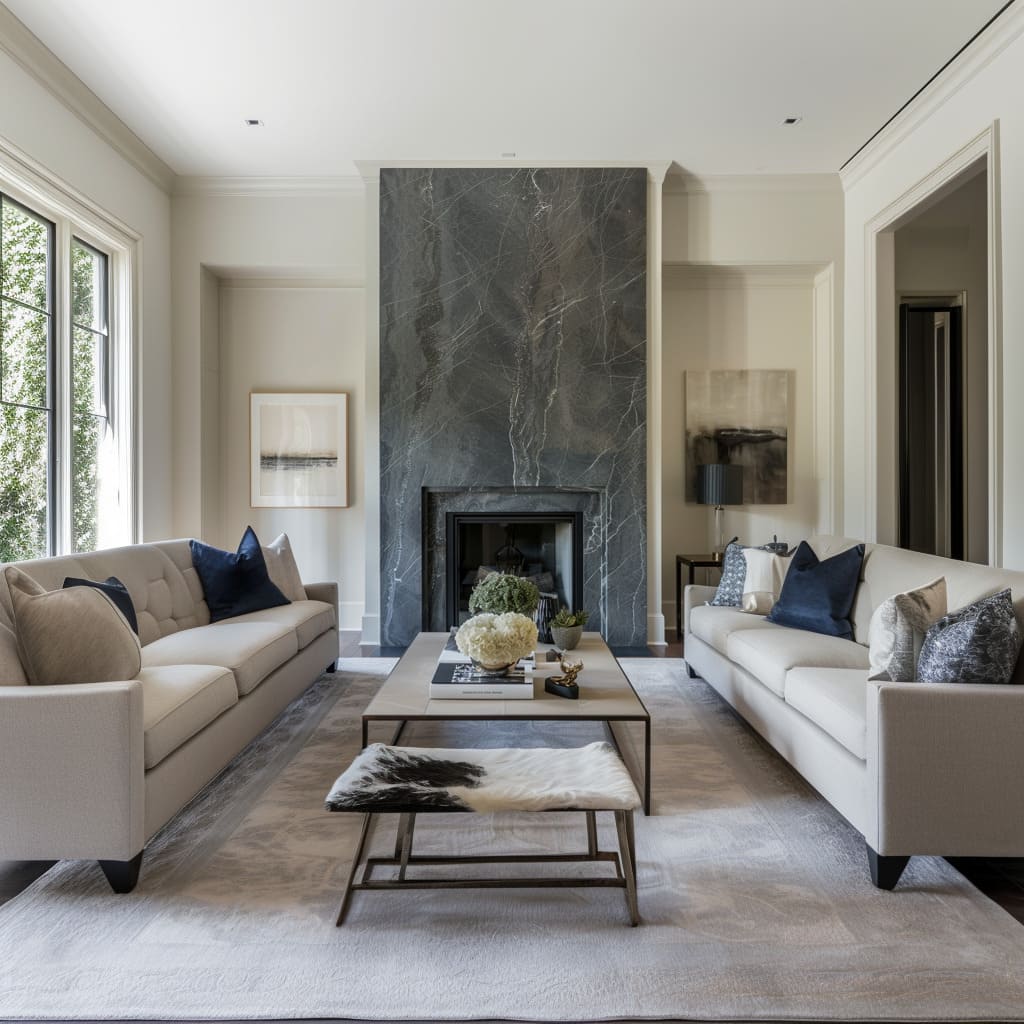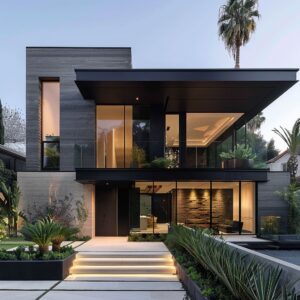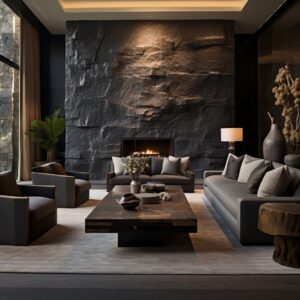Fireplaces have long been a central element in living room design, providing warmth, ambiance, and a gathering place for family and friends. They serve both functional and aesthetic purposes, transforming living spaces into cozy retreats during colder months and acting as impressive focal points year-round.
Among the various types of fireplaces, those constructed from stone stand out due to their timeless beauty and durability. Stone fireplaces draw attention with their natural textures, rich colors, and intricate patterns.
They effortlessly become the heart of the living room, commanding attention and admiration. Whether incorporated into modern or traditional interiors, stone fireplaces offer a versatile design element that can enhance a wide range of home styles.
In contemporary settings, stone fireplaces provide a striking contrast to sleek furniture and minimalist decor. The natural veining and varied textures of the stone introduce organic elements that soften modern lines and add depth to the room.
They can be designed with clean, sharp lines for a streamlined look or with more elaborate detailing for a touch of grandeur.
Traditional homes benefit equally from the inclusion of stone fireplaces. These structures can be crafted to echo the classical elegance of historical design, with intricate mantels and rich, earthy hues that complement wood paneling and antique furnishings.
The inherent solidity and permanence of stone lend a sense of stability and timelessness to traditional living spaces. The appeal of dramatic stone fireplaces lies not only in their visual impact but also in their ability to blend seamlessly with diverse interior styles.
They can be the unifying element in a room, bringing together various design components through their commanding presence and natural beauty. By choosing the right type of stone and design, homeowners can create a fireplace that serves as both a functional heating source and a stunning piece of architectural art.
Types of Stone Used in Fireplaces
Popular Types of Stone for Fireplaces
When selecting a stone for a fireplace, homeowners and designers alike seek materials that offer both beauty and practicality. The right stone can enhance the room’s aesthetics while providing durability and efficient heat retention.
Four types of stone commonly used in fireplace construction are soapstone, marble, granite, and limestone. Each of these stones brings unique characteristics and benefits that make them suitable for creating a striking and functional fireplace.
Soapstone
Soapstone is renowned for its heat retention properties.
This dense, metamorphic rock feels smooth to the touch and typically comes in shades of gray, with subtle veining patterns that add to its visual appeal. One of the standout features of soapstone is its ability to absorb and radiate heat, making it an excellent choice for fireplaces.
Unlike other stones, soapstone can withstand direct flames without being damaged, ensuring long-term durability.
Marble
Marble is synonymous with luxury and elegance. Known for its distinctive veining and wide range of colors, marble fireplaces can become the centerpiece of any living room.
The stone is formed from limestone subjected to intense heat and pressure, resulting in a material that is both strong and visually captivating. While marble requires more maintenance to keep its polished appearance, its aesthetic qualities make it a favorite among homeowners looking to add a touch of sophistication to their living spaces.
Granite
Granite is one of the hardest natural stones available, making it a durable choice for fireplaces.
Its speckled appearance and variety of colors can complement many design styles. Granite’s resilience to high temperatures and its resistance to scratches and stains make it a practical option for busy households.
This stone can handle the wear and tear of daily use while maintaining its polished look, ensuring that the fireplace remains a stunning feature in the living room.
Limestone
Limestone offers a more subdued, rustic charm compared to other stones. Its soft, muted colors and relatively uniform texture make it a versatile option for different interior styles.
Formed from sedimentary rock, limestone has a natural, earthy appearance that can create a warm and inviting atmosphere. While not as hard as granite, limestone is still durable and capable of withstanding the heat of a fireplace.
Its softer appearance can blend seamlessly with various decor elements, making it a popular choice for those seeking a more understated look.
Characteristics and Benefits of Each Stone Type
Durability
Durability is a key consideration when choosing a stone for a fireplace. Granite stands out as the most durable option, resistant to scratches, stains, and high temperatures.
Marble, while also durable, requires more care to maintain its pristine condition. Soapstone is durable in a different way, with its ability to withstand direct flames without damage.
Limestone, though softer, offers sufficient durability for fireplace use while contributing to a more relaxed, rustic aesthetic.
Heat Retention
Heat retention is another critical factor. Soapstone excels in this area, absorbing and radiating heat effectively, which can help keep a room warm long after the fire has gone out.
Granite also offers good heat retention, making it a practical choice for efficient heating. Marble and limestone provide moderate heat retention, sufficient for most household needs.
Aesthetic Qualities
Aesthetic qualities play a significant role in the selection process.
Marble is often chosen for its luxurious appearance and dramatic veining, adding a touch of elegance to any room. Soapstone’s smooth texture and subtle veining give it a unique, sophisticated look.
Granite’s variety of colors and patterns can match many design preferences, from traditional to modern. Limestone’s earthy tones and uniform texture offer a simpler, more natural look, ideal for creating a cozy and inviting atmosphere.
In summary, each type of stone offers distinct advantages and aesthetic qualities that can enhance the design and functionality of a fireplace. Whether prioritizing heat retention, durability, or visual appeal, homeowners can find a stone that meets their specific needs and complements their living room’s style.
Design and Structural Elements
Vertical Presence and Height
A fireplace that reaches from floor to ceiling creates a strong vertical presence in a room, drawing the eye upward and enhancing the sense of height and space. This design choice makes the fireplace a dominant feature, effectively anchoring the room’s layout.
Tall fireplaces can add a dramatic flair, particularly in rooms with high ceilings, where they emphasize the room’s scale and grandeur. The verticality of a floor-to-ceiling stone fireplace also allows for a larger expanse of stone, showcasing its natural beauty and texture more prominently.
Clean, Sharp Lines vs.
Intricate DetailingThe choice between clean, sharp lines and intricate detailing in fireplace design can significantly influence the room’s overall aesthetic. Clean lines offer a modern, streamlined look that works well in contemporary settings.
This minimalist approach highlights the natural beauty of the stone, letting its color and veining take center stage without additional embellishments. On the other hand, intricate detailing, such as carved mantels and ornate trim, lends a traditional or classical feel.
These details can add character and sophistication, making the fireplace a statement piece that reflects craftsmanship and attention to detail.
Mantelpiece Styles and Materials
The mantelpiece is a crucial element of the fireplace, offering both functional and decorative benefits. Mantel styles range from simple, understated ledges to elaborate, carved designs.
Materials for mantels can vary widely, from matching stone to contrasting materials like wood or metal. A stone mantel that matches the fireplace can create a seamless look, enhancing the fireplace’s verticality and solidity.
In contrast, a wooden mantel can introduce warmth and contrast, breaking up the stone’s expanse and adding a different texture. Metal mantels, particularly in modern designs, can add a sleek, industrial touch, providing a contemporary contrast to the natural stone.
Integration with Built-In Shelving and Cabinetry
Integrating built-in shelving and cabinetry around the fireplace can enhance both functionality and aesthetics.
These built-ins provide storage and display space, helping to organize the room and keep it clutter-free. Shelving can be used to showcase decorative items, books, and artwork, making the fireplace area a focal point not just for its visual appeal but also for its practical use.
Cabinetry offers concealed storage for media equipment, games, and other living room essentials. The design of these built-ins can be customized to complement the fireplace, using matching or contrasting materials and finishes to create a cohesive look.
One of the most crucial aspects of any home improvement project is understanding the costs involved. Budgeting accurately ensures your dream home doesn’t turn into a financial nightmare.
To help you plan effectively, we recommend using our Home Renovation and Remodel Cost Calculator. This tool is designed to give you a rough estimate of the expenses associated with your remodel.
Color and Texture
Natural Veining and Patterns in Stone
One of the most appealing aspects of stone fireplaces is the natural veining and patterns present in the material. These organic designs add depth and character, making each fireplace unique.
The veins can create striking visuals, ranging from subtle, wispy lines to bold, dramatic streaks. The complexity of these patterns can enhance the fireplace’s role as a central design element, drawing attention and adding visual interest.
The choice of stone with specific veining patterns can be tailored to the desired aesthetic, whether seeking a more subtle, elegant look or a bold, eye-catching statement.
Contrast with Surrounding Elements
A well-designed stone fireplace often contrasts with the surrounding elements to create a balanced and visually appealing space. This contrast can be achieved through color, texture, and scale.
For example, a dark stone fireplace can stand out against light-colored walls, creating a dramatic focal point. Conversely, a light stone fireplace against darker walls can brighten the room and add a sense of openness.
The contrast should be thoughtfully planned to ensure the fireplace enhances the overall design rather than overwhelming it. Integrating complementary colors and textures in furniture, rugs, and decor can help tie the fireplace into the broader room scheme.
Harmonizing with Color Palettes (Dark Tones with Light Neutrals)
Harmonizing the fireplace with the room’s color palette is essential for a cohesive look. Dark-toned stones like soapstone or slate can be paired with light neutral walls and furnishings to create a balanced and inviting space.
This combination allows the fireplace to stand out while maintaining harmony within the room. Light stones, such as limestone or white marble, can complement darker walls and rich wood tones, adding elegance and sophistication.
The interplay between dark and light elements can create a dynamic yet cohesive design, enhancing the room’s overall aesthetic.
Texture Variations and Their Visual Impact
The texture of the stone used in the fireplace contributes significantly to its visual impact. Smooth, polished stones offer a sleek and modern appearance, reflecting light and adding a touch of sophistication.
In contrast, rough-hewn or honed stones provide a more rustic, natural look, adding warmth and character. The choice of texture can influence the room’s ambiance, making it feel either more formal and refined or more casual and cozy.
Mixing different textures within the fireplace design, such as combining smooth mantels with rough stone surrounds, can add depth and complexity, creating a rich and layered visual experience.
By carefully considering these design and structural elements, homeowners can create a stone fireplace that not only serves as a functional heat source but also as a central piece of art that enhances the living room’s overall design. The interplay of vertical presence, clean lines, intricate details, mantel styles, and integrated shelving can transform a simple fireplace into a stunning architectural feature.
Similarly, thoughtful attention to color, texture, and contrast can ensure the fireplace harmonizes with the rest of the room, creating a cohesive and inviting space.
Placement and Symmetry
Centerpiece of the Room
A dramatic stone fireplace often serves as the centerpiece of the living room, providing a central focal point around which the rest of the room is designed. Its prominent position draws the eye and anchors the space, creating a sense of balance and cohesion.
The fireplace’s verticality and striking appearance make it an ideal focal point, ensuring that it remains the dominant feature in the room. This central placement helps define the room’s layout and guides the arrangement of furniture and decor.
Symmetrical Arrangements with Furniture
Symmetry plays a crucial role in enhancing the visual appeal of a room with a stone fireplace.
Placing matching furniture pieces on either side of the fireplace creates a harmonious and balanced look. For example, identical sofas or armchairs positioned on both sides of the fireplace can frame it beautifully, making the room feel well-organized and inviting.
This symmetrical arrangement not only highlights the fireplace but also makes the space feel more orderly and aesthetically pleasing. The use of symmetry can extend to other elements such as side tables, lamps, and decorative items, further enhancing the room’s overall balance.
Flanking Elements (Windows, Shelving Units)
Incorporating flanking elements like windows and shelving units around the fireplace can enhance its prominence and integrate it seamlessly into the room’s design. Large windows on either side of the fireplace allow natural light to flood the space, highlighting the stone’s texture and color.
This natural illumination can make the fireplace appear even more striking, adding to its visual impact. Shelving units, whether open or closed, provide additional storage and display space, framing the fireplace and creating a cohesive look.
These built-ins can house books, art pieces, and other decorative items, contributing to the room’s aesthetic while also offering practical functionality.
Complementary Furniture and Decor
Seating Arrangements (Sofas, Armchairs)
The seating arrangement is essential for creating a comfortable and functional living room centered around a stone fireplace. Sofas and armchairs should be arranged to maximize both comfort and the view of the fireplace.
A common layout includes placing a sofa directly facing the fireplace, with armchairs positioned on either side to create a cozy conversation area. This arrangement allows everyone in the room to enjoy the warmth and ambiance of the fireplace.
Choosing furniture that complements the fireplace’s style and color palette enhances the room’s overall cohesiveness.
Use of Throw Pillows and Cushions
Throw pillows and cushions are simple yet effective accessories for adding comfort and style to the seating arrangement. These items can introduce additional colors, patterns, and textures, creating visual interest and enhancing the room’s comfort.
When choosing throw pillows and cushions, consider selecting ones that complement the fireplace’s stone and the room’s overall color scheme. Mixing and matching different sizes, shapes, and fabrics can add depth and personality to the space.
Coffee and Side Tables
Coffee and side tables play a vital role in completing the living room’s functionality and style. A coffee table placed in front of the sofa provides a central surface for drinks, books, and decorative items.
Side tables positioned next to armchairs offer convenient spots for lamps and personal items. The materials and design of these tables should complement the fireplace and other furnishings.
Stone, metal, and wood are popular choices, each bringing a unique texture and character to the room. A stone coffee table can echo the fireplace’s material, while a wooden side table can add warmth and contrast.
Materials and Design (Stone, Metal, Wood)
The choice of materials for furniture and decor significantly impacts the room’s aesthetic.
Stone tables can enhance the room’s connection to the fireplace, creating a cohesive look. Metal elements, such as table legs or decorative accents, add a contemporary touch and can contrast nicely with the natural stone.
Wooden pieces introduce warmth and texture, balancing the harder surfaces of the stone and metal. Combining these materials thoughtfully can create a layered, visually rich environment.
Decorative Items (Vases, Trays, Books)
Decorative items like vases, trays, and books add personality and interest to the living room. These items can be strategically placed on coffee tables, side tables, and shelving units to enhance the room’s style.
Vases with fresh flowers or greenery bring a touch of nature indoors, adding color and life. Trays can be used to organize smaller items and add a decorative element.
Books not only provide reading material but also contribute to the room’s aesthetic, especially when arranged thoughtfully on shelves or tables.
Area Rugs and Flooring Choices
Area rugs and flooring choices play a crucial role in defining the space and adding comfort. An area rug placed under the seating arrangement can anchor the furniture and create a cozy, inviting feel.
The rug’s color, pattern, and texture should complement the fireplace and the overall design scheme. For flooring, natural materials like hardwood or stone tiles can enhance the room’s connection to the fireplace.
The choice of flooring should balance the room’s elements, providing a foundation that supports the overall aesthetic.
In summary, the placement and symmetry of furniture and decor around a dramatic stone fireplace are essential for creating a balanced and inviting living room. Thoughtful seating arrangements, the use of complementary materials, and carefully selected decorative items all contribute to a cohesive and stylish space.
By considering these elements, homeowners can design a living room that highlights the fireplace as the focal point while ensuring comfort and functionality.
Lighting and Natural Light
Role of Recessed Lighting
Recessed lighting plays a crucial role in illuminating living rooms with dramatic stone fireplaces. These unobtrusive fixtures provide a clean, streamlined look that enhances the room’s overall aesthetic.
Placed strategically in the ceiling, recessed lights can highlight the fireplace and other key areas without drawing attention to the fixtures themselves. They are ideal for creating a warm and inviting atmosphere, as they distribute light evenly across the space.
Recessed lighting can also be dimmed to set the mood, offering flexibility for different times of day and occasions.
Highlighting Architectural Features
In addition to general illumination, recessed lighting can be used to accentuate architectural features in the living room. Lights placed above the fireplace can draw attention to the stone’s texture and veining, enhancing its visual impact.
Similarly, recessed lights can highlight built-in shelving, molding, and other design elements, adding depth and dimension to the room. This technique not only showcases the craftsmanship and detail of these features but also creates a layered lighting effect that adds to the room’s ambiance.
Natural Light from Windows
Natural light is an essential component of any well-designed living room. Large windows on either side of the stone fireplace allow sunlight to flood the space, making it feel bright and airy.
The natural light enhances the stone’s color and texture, bringing out its natural beauty. It also creates a dynamic interplay of light and shadow, adding depth and interest to the room.
Positioning furniture to take advantage of the natural light can make the space more inviting and comfortable.
Framing and Dressing Windows
How windows are framed and dressed significantly impacts the room’s aesthetic and functionality. Trim and molding around the windows can add architectural interest and complement the fireplace.
When it comes to window treatments, curtains and drapes are popular choices. Floor-length curtains in a neutral tone can add elegance and help frame the windows without competing with the fireplace.
Sheer curtains can diffuse the light, creating a soft, filtered effect that enhances the room’s ambiance. For a more tailored look, Roman shades or blinds can provide a clean, modern appearance while allowing control over light and privacy.
Balancing Light and Privacy with Curtains
Balancing light and privacy is essential in a living room with large windows. Curtains and drapes can be layered to achieve this balance.
Sheer curtains allow light to filter in during the day while maintaining some level of privacy. Thicker, opaque drapes can be drawn in the evening for complete privacy and to block out unwanted light.
This layered approach provides flexibility, enabling homeowners to adjust the lighting and privacy levels according to their needs. Additionally, choosing curtains that complement the room’s color scheme and decor ensures a cohesive and stylish look.
Integration with Nature
Indoor Plants and Greenery
Incorporating indoor plants and greenery into the living room design adds a touch of nature and enhances the space’s overall ambiance. Plants bring life and color to the room, creating a fresh and vibrant atmosphere.
They can be placed on side tables, shelves, or even on the mantel above the fireplace. Choosing a variety of plants with different shapes, sizes, and textures adds visual interest and diversity.
Plants like ferns, succulents, and potted trees can thrive indoors and require minimal maintenance, making them ideal choices for enhancing the living room’s aesthetic.
Views of the Outdoors
Maximizing views of the outdoors can significantly enhance the living room’s connection to nature. Large windows that frame scenic vistas or garden views bring the outside in, making the space feel larger and more open.
The natural beauty of the outdoors complements the stone fireplace, creating a harmonious blend of indoor and outdoor elements. Arranging furniture to take advantage of these views allows residents and guests to enjoy the changing seasons and the beauty of nature from the comfort of the living room.
Bringing Elements of Nature Inside
Bringing natural elements inside extends beyond plants to include materials and decor inspired by the outdoors. Stone, wood, and natural fibers can be incorporated into the living room’s design to enhance its connection to nature.
A wooden coffee table or side table can complement the stone fireplace and add warmth to the room. Textiles like linen, wool, and cotton can be used for cushions, throws, and rugs, adding texture and a natural feel.
Decorative items like stones, shells, and driftwood can be artfully arranged on shelves and tables to reinforce the room’s natural theme. Incorporating nature into the living room design not only enhances its aesthetic appeal but also creates a calming and rejuvenating environment.
The combination of natural light, indoor plants, and outdoor views fosters a sense of well-being and connection to the natural world. By thoughtfully integrating these elements, homeowners can create a living space that feels both inviting and harmonious, with the dramatic stone fireplace serving as the central feature that ties everything together.
Artwork and Decorative Items
Selecting Artwork to Complement the Stone Fireplace
Choosing the right artwork to accompany a stone fireplace can elevate the room’s aesthetic. The fireplace’s natural texture and color provide a rich backdrop for various art styles, allowing homeowners to create a harmonious or contrasting visual effect.
When selecting artwork, consider the stone’s hues and patterns, ensuring the pieces complement rather than compete with the fireplace. Artwork should enhance the room’s overall design, adding depth and interest without overshadowing the fireplace’s inherent beauty.
Abstract vs. Traditional Art
The decision between abstract and traditional art depends on the desired ambiance and the room’s overall decor style.
Abstract art, with its bold shapes and vibrant colors, can provide a modern, dynamic contrast to the natural stone. It adds a contemporary edge, drawing attention and sparking conversation.
Conversely, traditional art, with its classic themes and detailed execution, can harmonize with the timeless elegance of the stone. This type of art creates a more subdued, sophisticated atmosphere, complementing the fireplace’s rustic charm.
Color Coordination with the Fireplace
Color coordination is crucial when integrating artwork into a room with a stone fireplace. The art should either echo the stone’s natural tones or provide a striking contrast.
For instance, artwork featuring shades of gray, beige, or brown can blend seamlessly with a soapstone or limestone fireplace, creating a cohesive look. Alternatively, vibrant colors like blues, reds, or yellows can stand out against a darker stone, adding a pop of color and drawing the eye.
The key is to maintain a balance, ensuring the art enhances the room’s aesthetic without overwhelming it.
Decorative Items on Mantels and Tables
Decorative items placed on mantels and tables can further accentuate the stone fireplace. These items should be thoughtfully chosen to complement the fireplace’s design and the room’s overall decor.
A well-curated selection of vases, sculptures, and candles can add personality and charm, making the space feel lived-in and welcoming.
Vases, Sculptures, Candles
Vases filled with fresh flowers or greenery can introduce a touch of nature, adding color and life to the room. They can be chosen to match the room’s color scheme or to provide a contrast, depending on the desired effect.
Sculptures, whether abstract or traditional, can add a layer of sophistication and artistic interest. They should be placed strategically to draw attention to the fireplace without cluttering the space.
Candles, both functional and decorative, can enhance the room’s ambiance. When lit, they provide a warm, flickering light that complements the fireplace’s glow, creating a cozy, inviting atmosphere.
Functional and Aesthetic Considerations
Heating Efficiency of Stone Fireplaces
Stone fireplaces are valued not only for their aesthetic appeal but also for their practical benefits. One of the primary functional considerations is the heating efficiency.
Stone, particularly types like soapstone, retains heat effectively. Once heated, the stone continues to radiate warmth long after the fire has died down, helping to maintain a comfortable temperature in the room.
This quality makes stone fireplaces a practical choice for homeowners looking to enhance both the style and functionality of their living spaces.
Maintenance and Care of Stone Surfaces
Maintaining the beauty of a stone fireplace requires regular care. Different types of stone have varying maintenance needs.
For example, soapstone is relatively low-maintenance but benefits from periodic oiling to enhance its color and luster. Marble, while elegant, can be prone to staining and requires gentle cleaning with non-abrasive products.
Granite is highly durable but should be sealed periodically to prevent moisture penetration and staining. Limestone, being softer, needs careful handling to avoid scratches and should be cleaned with a mild detergent and soft cloth.
Regular maintenance ensures the stone retains its natural beauty and continues to enhance the room’s aesthetic.
Balancing Aesthetics with Practical Use
Achieving a balance between aesthetics and practical use is essential when incorporating a stone fireplace into a living room. The fireplace should serve as a beautiful focal point while also meeting the functional needs of the household.
This balance can be achieved through thoughtful design choices. For instance, selecting furniture that is both stylish and comfortable ensures the room is visually appealing and practical for everyday use.
Incorporating storage solutions like built-in shelving can keep the space organized without detracting from the fireplace’s beauty. Additionally, choosing durable materials for furniture and decor items ensures they withstand the wear and tear of daily life while maintaining their aesthetic appeal.
In conclusion, the integration of artwork and decorative items with a stone fireplace enhances the room’s visual appeal, creating a cohesive and inviting space. Careful selection and placement of these elements ensure they complement the fireplace and the room’s overall design.
Balancing the aesthetic and practical aspects of the fireplace and surrounding decor ensures a living room that is not only beautiful but also functional and comfortable. By considering these factors, homeowners can create a space that showcases the dramatic stone fireplace as the heart of their home.
Conclusion
Throughout this article, we have explored the many facets of incorporating a dramatic stone fireplace into a living room. We began by discussing the different types of stone available, including soapstone, marble, granite, and limestone, and their unique characteristics.
We then delved into design and structural elements, such as vertical presence, mantelpiece styles, and the integration of built-in shelving. We also covered color and texture considerations, placement and symmetry, complementary furniture and decor, lighting, and the integration of natural elements.
Lastly, we provided detailed examples and visual inspirations to help bring these concepts to life.
Final Thoughts on the Enduring Appeal of Dramatic Stone Fireplaces in US Homes
Dramatic stone fireplaces continue to be a beloved feature in US homes, offering both aesthetic and practical benefits. Their natural beauty, durability, and versatility make them an ideal choice for any living room.
Whether you prefer the sleek look of soapstone, the luxury of marble, the resilience of granite, or the rustic charm of limestone, a stone fireplace can elevate your living space, making it a focal point that draws admiration and provides warmth.
Encouragement to Consider Stone Fireplaces as a Central Design Element in Living Rooms
If you are considering a renovation or looking to enhance your living room, a stone fireplace can serve as a stunning central design element. Its ability to complement various styles, provide efficient heating, and add architectural interest makes it a worthwhile investment.
By thoughtfully selecting the type of stone, design details, and complementary decor, you can create a living room that is both beautiful and functional, centered around the timeless appeal of a dramatic stone fireplace.


